#sisko is looking out of the station into the stars
Explore tagged Tumblr posts
Text
what gets me about far beyond the stars is that unlike other sci-fi or supernatural shows that have a “maybe it’s all a dream” episode, this episode ends with hope that even if the entirety of star trek is just benny’s imagination, just his dream, what a good dream it is
#star trek#star trek deep space nine#star trek ds9#st ds9#ds9#deep space nine#benjamin sisko#captain benjamin sisko#captain sisko#benny russell#far beyond the stars#I rewatched the ep today for its 25 anniversary#and this popped in my head#sisko is looking out of the station into the stars#and he isn’t anxious or upset that he might not be real#and it even gives him the courage to keep moving forward#because if it is benny’s dream he wants to make sure it’s a good dream#one that would give benny hope in return#it’s just such a well done episode and Avery brooks was incredible in his performance and direction of it
643 notes
·
View notes
Text
Rewatching DS9 again and I am just so interested at how an average Bajoran would view Kira by the end of the series. How an average Cardassian would? We know that a lot of what she does is known to the Bajoran people. Shakaar mentions Furel and Lupaza bragging about her whenever they get news of the station. But lets actually take a look at this:
She is the highest ranking Bajoran on DS9 outranked only by the Emissary
Most times Sisko did anything in the capacity as the Emissary, Kira was one step behind and to the right
She was with Kai Opaka, the most widely loved and respected Bajoran, when she made her journey through the Celestial Temple and “answered the call of the prophets”
She was highly respected (and loved) by Vedek Bareil who was hugely popular on Bajor (he could very well have been Kai if he hadn’t taken the blame for Kai Opaka’s actions during the Occupation)
She and Kai Winn had a well known feud and after Kai Winn’s fall from grace at the end of the show, Kira must come out pretty great to everyone else
She is the one who found and saved the great Bajoran hero, Li Nalas, from a Cardassian work camp and then within a week saved Bajor from a civil war that had been encouraged by Cardassians.
Between her saving Li Nalas and his fellow prisoners AND finding the Ravinok and saving the Bajorans (and Cardassians and Ziyal) from the Breen mines, was she the person Bajorans turned to when searching for their lost love ones? Was she a symbol to those who kept looking for their loved ones because Kira Nerys found those thought to be lost?
She prevented ANOTHER Bajoran Civil War and helped elect Shakaar as the First Minister of Bajor. Again being associated with a widely loved and respected member of Bajoran society.
Kira was in charge of DS9 during Dominion Occupation and started up the station’s resistance cell
She was permitted to use the Orb of Time, one of Bajor’s most sacred objects
She was the chosen by a Prophet to be their vessel during the Reckoning with the Pah-Wraith...and the KAI was on the same station. But it was KIRA who was chosen
She plays chicken with a Romulan fleet...and wins!
She was a key figure in the Dominion War. She started as a resistance fighter who was assigned to a falling apart, unimportant old Cardassain station and becomes the Colonel of the single most important port in the Alpha Quadrant. She is the right hand of the Emissary. She is widely respected by many beloved figures in Bajoran society.
And this list is just the most public things that have happened to her. This doesn’t even take into account any of the stories about her that involve her dealing with whatever BS the Star Trek universe decides to throw at the characters that week. Klingons beam in and fight? Gets stabbed and keeps fighting. Emissary is transported to 2024? Kira is on the team that pulls him out.
By the end of season seven, do politicians on Bajor hold their breath or breathe a sigh of relief if Kira gets involved? Do Vedeks seek her out to ask her about being possessed by a prophet? About her experiences with the Orbs? About Kai Opaka’s last words? Do families still grieving those missing from the Occupation petition her to look for the lost?
And how about the Cardassians?
The Cardassian government would probably never publicly admit to any time she foiled their plans, but Tekeny Ghemor tells her that she has her own section in the Cardassian Central Archives and is a public figure on Cardassia
Would the Cardassians in the Breen mine whisper their thanks among their family that Kira Nerys found them?
Tekeny Ghemor, someone who was respected enough to be considered as the face for the Cardassian resistance against the Dominion controlled Cardassian puppet government, publicly considered her his daughter/family by asking her to participate in the Shri-tal ritual and give her all of his secrets prior to his death (something highly valued in Cardassian society)
She was a part of Damar’s resistance. She helped them fight the Dominion and was with Damar when he died for Cardassia. In the story of how Damar was martyred for Cardassia’s freedom from the Dominion, Kira Nerys, a Bajoran, is heavily featured.
In all Bajoran/Cardassian relations, do Cardassians seek to involve Kira as a woman of her word who will treat in good faith or do they cross their fingers and hope she is nowhere near their business?
Can you tell I think about Kira Nerys a lot?
#DS9#Deep Space Nine#Kira Nerys#I love Kira so very very much#Her character development over all seven seasons is beautiful to watch#And I think everyone should love her#Everyone on DS9 must have a reputation on Bajor just#by proximity to The Plot#And obviously Sisko is probably the most prominent figure between Bajoran Cardassian Federation and Maquis society#But I argue that Kira is the next well known with her own mini following on Bajor and maybe even Cardassia
2K notes
·
View notes
Text
Ben tapped his fingers on the side of his mug idly. He knew that he had to deal with the problem of Garak soon. He’d meant to act more quickly on the matter, but many other far more urgent issues had needed addressing in his first week as commander of the station, and it had slipped to the back burner. He still had never even met the man—never even seen him in person until this moment—but he was already under pressure from all sides to deal with him.
The Garak problem was simple: the Bajoran Provisional Government wanted him, like the rest of the Cardassians, gone. A reasonable request, which was nevertheless shaping up to be a real bureaucratic and diplomatic nightmare.
Past Prologue Sisko POV fic! There’s some Garashir too, but the fic is much more focused on Sisko trying to figure out what Garak’s whole deal is.
44 notes
·
View notes
Text
POLL TAG- FIVE FAVORITE CHARACTERS
tagged by @wen-kexing-apologist.
Challenge: make a poll with five of your all time favorite characters, and then tag five people to do the same. See which character is everyone's favorite.
I am choosing to limit myself to BL characters because otherwise we'd have a Will Graham (an unhinged FBI profiler in Hannibal) vs Yu Ji Ho (the boundary-respecting pharmacist single dad in One Spring Night) vs Bart (the Universe-appointed holistic assassin in Dirk Gently's Holistic Detective Agency) vs Benjamin Sisko (the legendary single dad and captain of the space station in Star Trek Deep Space Nine) type of situation going on.
The Spiel - IN DEFENSE OF MY FAVES
Nozue (Old Fashion Cupcake)

Everyone's favorite boss with a heart of gold, this 39yo repressed hottie could flirt like a pro. My favorite thing about him is that he experienced utterly transformative character growth without having to experience severe pain (a breakup, a loved one's death, job loss, rejection, etc). He just looked at where he was standing and... stepped left.
Kakeru (I Cannot Reach You)

My boy learned his childhood bestie had a crush on him and did not flee in terror. Instead he faced it and asked for patience and examined his feelings and treated the potential change in their relationship as seriously as it deserved to be treated because the request came from someone he loved. Clearly, this is a boy who knows how to spell R-E-S-P-E-C-T.
Wei Qian (Unknown)

He stepped up and raised his younger sibling when their druggie mother died, then added an adoptee into the mix. And he cared for them so profoundly that they had relatively normal childhoods despite being orphans. Yet this softie was tough enough to be a gang enforcer, and then smart enough to get a college degree, and then competent enough to co-create a successful startup. Like what kind of super hero bullshit is he on?
Karan (Cherry Magic, Thailand)

A competent and talented employee, and he's a total simp who looks great in or out of a suit? Sign me up for his tender loving care, y'all. I literally melted into a puddle of goo every time we saw a glimpse of his very earnest yet sweet fantasies. He just wants to take care of his boo!
Iwanaga (Love Is Better The Second Time Around)

I confess he's here mostly because he's eye candy. (Well that and recency bias, because if we're really talking about my favorite eye candy, it'd be Porsche from Kinnporsche without a second's hesitation.) But roll with me here, please? This man can fuck! And fuck so well he pissed off the love of his life! And all the men in town are dropping for him like flies. They get one hint of a taste of his juice and they're down bad! They're hooked. They're his. He is legendary. He is epic. He knows how to work his angles and his puppy dog eyes! And he's also talented and wealthy and considerate to boot.
***
Most of my mutuals have probably played already, but if you care to go again or want an excuse to play by different rules, please consider yourself tagged. Also I'm tagging some of you just in case you haven't done it yet because tbh I haven't been paying that close of attention to my dash this week: @absolutebl, @syrinth, @dean-you-assbutt-cas-loves-you, @lurkingshan, @bengiyo, @chickenstrangers, @thequeenofsastiel, @tiggymalvern, @spicyvampire, @my-rose-tinted-glasses, @wanderlust-in-my-soul, @twig-tea, @telomeke, @guzhu-furen, @gunsatthaphan, @lymeandcoconut, @itwoodbeprefect, @shortpplfedup
36 notes
·
View notes
Text
✮I Won’t Say I’m In Love✮

Weyoun x GN! Reader


Star Trek Masterlist
Summary: The reader is helplessly in love with Weyoun, but is torn between loyalty to Starfleet and their love for the Vorta. (Spoiler, love wins this round)
A/n: I don’t edit my work so forgive me if it’s illegible at points </3, this is also my first time writing Weyoun so I’m sorry if he’s mischaracterised. I thought this would turn out better than it did but we move 🤞 (it’s a bit rushed and I didn’t take it seriously this was mostly for fun and myself)

Living on Deep Space Nine for the past five years has certainly come with its challenges, but nothing was more challenging than falling head over heels for a pretty but manipulative diplomat that was technically an enemy at this point. You weren’t in on the mission to the Gamma Quadrant a year ago when renegade Jem’Hadar attacked the station and their own people, and Sisko sent out to go find them. But when they came back, Jadzia and Miles told you all about the mission and this Vorta named Weyoun. You didn’t think twice about the name, not that you would meet him, he got vaporised anyway. Though, he had appeared on the station the following year with Dukat, Sisko explained how Weyoun was immortal by cloning, that was interesting enough but was captivated you were his violet eyes, it set your stomach fluttering and your skin shivering. It really didn’t help that you had to show him around the station and be his little federation tour guide for that week. To make matters worse he invited you to dinner that week, wanting your input on what to eat. You spent the time in his guest quarters ordering anything and everything from the replicator and having him shuffle through your human music playlists. Not that he really understood alot of the inspiration behind it, being aesthetically held back. That aside he throughly enjoyed pop music from the 80’s, 90’s and some 2000’s (he loved Lady Gaga specifically), and throughly enjoyed your company. You laughed your ass off at him not knowing how to properly use utensils with the food, and having to teach him was even more of a blast for the both you, him chuckling as you corrected his form and which utensil to use. Standing behind him holding those soft warm hands as you showed him how to use a knife and fork... Oh good god don’t even talk about those pretty big eyes looking up at you when he followed an instruction and asked, “Is this correct?” Your heart could explode. You didn’t know if it was a manipulative tactic or not, but whatever it was, it worked. It worked well, because after you left his quarters you laid wake in bed, looking up at the ceiling. You scream into a pillow. God he is gorgeous it hurt.
For the next few weeks you just can’t get him out of your head, he’s not on the station but every time you see purple clothes in the corner of your eye you whip your head around. Down bad is the right phrase. Guilt is mixed with this feeling of infatuation, guilty of the fact that he’s a liaison for the Dominion, a enemy, he’s probably been a centrepiece for the Dominion conquering new worlds and slaughtering the ones who resist the founders rule. But why was he so… perfect. He felt so real. Yes he could possibly be trying to fish Federation secrets out of you, but why just a simple lieutenant? His attention doesn’t make much sense. But your heart start beating and fluttering like it never has before when you get a subspace message from him to your quarters. ‘I’m coming aboard the station again in about a week to negotiate with the Bajoran people, it would so delightful if we could spend time together again when I am off duty. Care to join me for more dinner lieutenant? I promise I’ve been brushing up on my table manners while away from you and station.’ You can hear that beautiful smile through the screen. How could you say no?
You were really in it now, for the weeks you’ve been pining and itching at your skin to just get it out to somebody, but you can’t. Not even to Quark. If you told your friends they’d look at you like you’re dead insane, you haven’t even told them about you and Weyoun having dinner. You hear the things they say about him to Odo. ‘He’s a slimy manipulative weasel.’ ‘He obeys the Founders and nothing else.’. But that’s not true, he’s his own person, even if it’s suppressed under his genetics that force him to blindly follow the founder, he is still an individual. You’ve had countless conversations about culture, and he was very interested in the arts and aesthetics. He internally yearns to be free spirited and autonomous. You can see the passion in his eyes, and you can’t help but sympathise. You can practically hear Jadzia and Kira gasp in shock if you told them. Or Quark laughing his ass off until he realises you’re not joking and an awkward silence would ensue. ‘It’ll pass’ you tell yourself. You fucking liar. Every day crawling closer to his return to the station and the butterflies in your stomach flutter against your drumming heart. It’s kind of pathetic how many times you had to snap yourself out of a Weyoun filled daydream while on duty.
The day came where he would dock onto the station. Forcing yourself to keep your distance that day and while he was there, and only see him for what you had previously arranged. Your com-badge beeped that morning after you gave yourself a pep talk on how liking a war criminal is stupid. “Lieutenant,” It was Sisko. “Weyoun has just docked and asking for you. He says you really mad him feel welcome last time and he would enjoy having your ‘expertise’ again.” You can Sisko’s disdain for Weyoun seeping through his tone when talking about him. All you can think about is how Weyoun specifically wanted you to be by his side again. “Yes, ofcourse sir, on my way.” You respond. Well there goes your distancing plans. The universe is clearly trying to tell you something.
Stepping off the turbo-lift to the right deck on the docking ring, you see at an airlock where the Dominion ship is docked. As beautiful as art, meticulously crafted and carved by gods (literally), he stands with that fake but wonderful smile politely taking to the Captain. “There they are.” Sisko notices you, eager to get Weyoun off his hands and give him to you. Weyoun can’t see you that clearly from a far but his eyes still twinkle and shine when he sees you approach. ‘It’s just the lights’ you think, trying not to let your crush blind you. ‘You’re on duty. Be civil.’ Your left brain berates you. “Ah, absolutely lovely, it really is a delight to see you again.” He clasps his hands behind his back with a little bow to you. “Shall we be off?” He adds, and you try your best not to blush in-front of Captain Sisko. “Yes, of-course I’ll show to the conference room.” You said, nodding, and glancing to Captain Sisko who seems sympathetic on your behalf that you have to spend time with Weyoun. (He doesn’t know what he’s missing). You walk down the corridors, just you and him again, and two Jem’Hadar soilders behind you keeping their distance. “It is wonderful to see you again Lieutenant. Have I already said that? Oh dear, I suppose I have. But there’s no harm in saying it again when it’s true.” He can’t seem to hide his excitement around you. “Yeah- I guess me too.” You internally facepalm at your awkwardness. “Are you still up for dinner with me?” He asks, those violet eyes and lilac face filling your senses. “Yes, yes of course. I’ll have my quarters set up tomorrow as planned.” You say, gulping down your feelings. Why was he affecting you so intensely? Get a GOD DAMN GRIP MAN. “Delightful, and if your schedule is open perhaps tonight we can have a little spin at the Dabo wheels?” He has a little bounce in his step as he thinks of the prospect. You know you shouldn’t, having a private dinner together is fine, but out in public with him? At Quarks no less, it will definitely get you odd looks and rumours spreading round fast. “Uhm, I’ll have to check, maybe not…” You grimace internally at the slight rejection to him. “Oh… I see. Well hopefully some other time then.” His step faltering a bit, you don’t know if it’s because he expected a different answer physiologically or because he was upset by the response. Either way your heart ached when the little mole above his top lip dropped with his smile. Though he quickly regained it.
When you dropped him off at the conference room where he’d be speaking to Bajoran delegates, you needed a drink. Stat. You needed to clear your brain, and you went straight to Quarks. For the next few hours you sat by a booth, nursing an Icoberry Spritzer, the purple seeming all too familiar to you in a different context. You groaned softly to yourself. Your miserable state catches the attention of your friends just coming off duty and into Quarks. Jadzia and Kira being the ones to come over. “And whats with the long face hm? The voles been in your walls again?” Jadzia asks making a joke to try get a smile out of you. “Don’t try, they’ve been sitting like that forever.” Jake says, you look over not even noticing Jake had been sitting close by on one of the support beams working on a story. “How long have you been there?” You give a small shocked glare. “Like I said. Forever.” Jake rolls his eyes, addressing Jadzia and Kira only, being vague and dodging the question. Kira sits down in the booth next to you, “Come on, what’s wrong?” She asked prodding you. “Nothing.” You said, trying to sound as convincing as possible. Jadzia crosses her arms, up to challenge, with a shit eating smirk and raising an eyebrow, “Oh no no, you can’t get off that easily.” “At least give us a hint” Kira added with a small huff. “Just leave it alone- and Jake shut up go do some writing elsewhere, you should stop learning eavesdropping habits from Nog. At least Nog is sneaky with it.” You say seeing Jake’s mouth move in the corner of your eyes and he sighs keeping his mouth shut.
“Then I’ll have to start guessing.” Jadzia started, “Work load? Waking up on the wrong side of the bed? You saw someone you hate? You saw someone you like…?” When Jadzia asked the last prompt your face, though you tried to push it down, was flushing madly. Both Jadzia and Kira’s face dropped in shock and rose with glee. ‘Oooos’ and squeals ensued, flowing you basically getting chased out of the booth for answers. You made it to the stairs and Quark being nosey for gossip sees and hears the scene. “What’s going on?” He asks as he wipes down a cup in his hand. “Well if you must know, our dear friend here finally has a crush.” Jadzia tells him. Quark really drops the glass, “uh- uh, really?” Now he’s a bit flustered. “Oh jeez Quark obviously not on you.” Kira points out, exasperated. “No, ofcourse not…” Quark has had a little crush on you for sometime after Worf and Jadzia started being a thing. “Who ever it is, is damn lucky” He changes his demeanour back to a more bartendery mood (what ever that means) giving you a wink and a pat on the shoulder for good luck, while you’re a bit petrified that your friends are trying to pry out your darkest secrets. Jadzia whips her head back to you, and like a woman dire of some good juice gossip she pleads and grovels, “Just tell us already!”
You technically run away from them up the stairs to the second floor of Quarks, and they follow. You hold onto the railing of the balcony, seeing the inside of Quarks and a good portion of both floors of the promenade. Kira and Jadzia catch up, one on each side of you. “I can see it on your face you’re in love.” Kira says, and you glare at her but it’s not convincing. “Am not.” You protest. “I’ve lived many life times, you’re not fooling anyone. Just say you’re in love.” Jadzia says. “And don’t forget to tell us who it is.” Kira quickly adds. You shake your head and stare to the promenade, hoping that not looking at them will make them go away. “I won’t say I’m in love.” You sigh and rest your arms on the railing, laying your head on them. “And we’re not buying it.” Kira leans closer. You look to her then back to the promenade, standing up pin straight, your body on high alert when you see Weyoun walking on the upper level with one of the Bajoran diplomats. Your heart lurched out your chest, and it didn’t go unnoticed, Jadzia and Kira looking in the direction you’re looking. They both gasp, for a moment you’re terrified they’ll judge you, but then they look at you with huge fat grins on their faces. “Oh please tell me you’re joking!” Kira says, and you shake your head a bit bewildered that they’re taking it so well. “Why didn’t you say something earlier! Have you seen the way he looks at you?” Jadzia says, astonished. Oh those purple eyes fill your head again and you have to glimpse at him again walking on the promenade. “Have you said anything to him yet?” Kira asks “No ofcourse not.” You answer, shocked why she would even think that. “Has he asked you on a date yet?” Jadzia fires the next question. “Does dinner count…?” You’re still so confused on how chill they are about this. “Yes it counts! When is your next date?!” They’re both bouncing by now. “Uh- tomorrow, dinner at mine-“ “do you plan to tell him?” “Uh no-“ “Why not!? Please you have to! He likes you I know it!” You barely have enough time to breathe between questions but the overflowing enthusiasm and encouragement makes you feel like maybe this isn’t so wrong. “Okay- I… I will.” You say. Well you’ll definitely try to tell him.
(Unbeknownst to you Kira and Jadzia thought you were looking at Julian because he walked past the same time that Weyoun did. Whoopsie)
(Yes Julian has a crush on you)
The day passed extremely slowly. And the next, until night. You had dinner set up hours too early, nearly burning a hole into the floor with your pacing. Then the chime ringed, you went for the door, hissing open to reveal Weyoun, you ushered him in trying not to be too nervous. “And what, my favourite Lieutenant, do you have lined up for my Vorta appetite.” He says, situating in his chair by the table. “Please, you know you can call me by my name when we’re alone. And I have basically everything you have missed out on last time you were here.” You giggled, god it was also just so easy to get into conversation with him. Your fears and troubles melt away. Except the lingering worry of rejection. Just stuff it down. Just stuff it down. All in good time.
While you were plating Weyoun the third little human starter for the night, (gluttonous beast), by the replicator. He comes up behind you, nearly resting his chin on your shoulder he’s so close. “I really did miss you today in the briefing room… it’s all so tedious and repetitive, I’d much rather be spending time with you. You’ve become very special and dear to me.” He admits softly, this being a bit more vulnerable. Your heart stopped dead in your chest. You move your face, your lips so close together, “You’re… special to me too.” You admit softly. The tension is thick in the air, but a beep from the replicator cuts right through it, ruining the moment. You clear your throat and plate yourself food. “Uhm- here… it’s an old human staple dish, Mac and Cheese.” You say. But inside you’re screaming and banging on the walls of your enclosure, he was RIGHT THERE. GODDAMNIT.
‘Tell him.’ ‘Tell him.’ It was like a mantra in your mind as you gripped your pant leg under the table, seeing him enjoy the texture of the food, like cute ‘mm’ and ‘oo’s emanating from him. It was torture being like this, but you just couldn’t bring yourself to tell him. I mean, he’s a Vorta, are they even programmed to love? Well he did say he missed you… That is something. “I have also been listening to your human music that you gave me last time I was here.” He said after patting the corners of his mouth. “Oh? Yeah, and did you like it?” “Absolutely splendid, Human creativity has always intrigued me. You intrigue me.” Holy fuck is he just effortlessly good at making you blush? Or is he just trying to manipulate you…? Your brain starts to doubt itself. “I sometimes wish you were on Cardassia with me, it would be it more exciting than being stuck with Dukat and Damar everyday.” He chuckles, your heart is pulsating dangerously again. “Ah- really…?” “Yes, and I’m not just saying that because I want you in the Dominion. I’m saying that because I want you with me. I sometimes find myself doing things and wondering what you would do if you were there with me… Again I’m not trying to get you to join the Dominion- believe me, it would be lovely if you did, but just your company… it’s unlike anything I have experienced really. You seem to care for me. Yes I know the Founders care, but you’re individually caring for me. You’re not bound by duty like the Jem’Hadar are to be at my side. You just… want to be there…” His voice is sincere, even cracking a bit maybe, he’s not using his diplomatic nature to sway you, he’s just upfront and honest. “Well, I hope you want to be here with me.” He adds, his thumbs fiddling with each other as his hands are clasped together on the table.
“I do want to be here. I wouldn’t have let you come to quarters for dinner if I didn’t…” You put your hand over his intwined ones, and he opens them up to hold your hand between both of his. Lightly tracing your skin and caressing it with his thumb. Giving a small smile and gleeful exhale as he looks at your hand. Enjoying the feeling of your skin, it’s real, warm and alive. Not cold padds with treaty’s and orders. There’s a small pause, just enjoying this feeling, you are really enjoying it too, you’re amazed at how you’re not freaking the fuck out. But something itching inside you speaks up, “Don’t you… ever feel guilty? I mean about this, about our friendship. We’re not exactly on the same side.” You ask, regretting some of the word choice. “I wouldn’t say guilt my dear. But there is an unusualness to it, a forbidden sense. Why do you ask? Do you wish to end this? Are you too uncomfortable by our likeliness?” “No-! No, no, I don’t want to end it. I enjoy this. I don’t know emotions are just confusing…” You respond. “There’s no need to worry about it. It’s just the two of us here. This doesn’t concern Starfleet or the Dominion. This is separate from that.” He empathises by squeezing your hand. God you could swoon, he always knows exactly what to say. “Now let’s have some dessert.” He says with a hint of excitement and you playfully roll your eyes, he always rushes to the dessert part.
The night ends with some chocolate cake and then you and Weyoun walking to the airlock where his ship is docked. You curse yourself that you didn’t work up the courage to tell him your feelings. ‘Fuck my life man’ You think. The airlock door rolls open when he steps up. “Well that was a lovely tasty dinner as always.” He says stepping over the threshold. “If I think of any more things for you to taste and try out I’ll definitely contact you.” You say to him. He looks back to you, “Are you sure I can’t entice you with some more dessert? You can come aboard the ship and I’ll get us some ripple-berry sorbet.” He asks, holding out a hand. You think what the hell, sure. You nod, “I don’t see why not.” You take his hand and step up over the threshold, but your boot hooks on it and you stumble. Weyoun is on it and catches you, his hand on your upperback just under your neck, his other hand still holding yours, almost like dipping you in a dance. Your hands don’t even know how they found themselves on his shoulders, but they’re not leaving that spot.
“I’ve always wondered what a kiss would taste like…”
And with that, he leans down and presses his lips to yours softly, for a moment you’re frozen but kiss him back in return, and he takes that acceptance and runs with it. Moving his hand to the back of your head, the other on your waist, he might be inexperienced but not stupid, he’s seen this in other species. The kiss itself is soft but passionate, your arms around his neck, hand in his fluffy muffin top hair. He’s soft and warm, tastes like a macaron and feels like heaven itself.
There’s not tongue in the kiss, just pure tenderness and unspoken words. But once you both have to catch your breath, it feels like there’s nothing between the two of you now, you can be what you want. Weyoun burrows his face into your neck like a cat, “Absolutely delicious… may I have a second serving?” Seriously? Is he joking at this time? But you can’t say no. You kiss him again, and pepper kisses all over his face in which he chuckles in delight as he gets smothered by this new found intimacy and experience.
He loves you too.


A/n: hoes this was ass forgive me (but thank you for my pookies on the server for cheering me on)
8 notes
·
View notes
Text
To celebrate Star Trek DS9’s 32nd anniversary, I read the “Emissary” novelization. Overall, I really liked it.
Early on, there’s this quote: “Sisko realized he was bigoted against bigots, but it was one bias he did not strive to transcend.” Page 23 in my edition) That is certainly a good way of framing the paradox of tolerance.
About a hundred pages later, there’s a section in Jake’s POV about how Benjamin has been teaching Jake on respecting different cultural beliefs. The handling of Jake and Nog’s interactions is a bit rough and I’m not quite sure yet how I feel about it. Poor Rom hasn’t been named yet at this point- he appears but only is referred to as Nog’s father. Going back to Jake, I do appreciate how the novelization is more open about how Jake has also been grieving and has been affected by his father being ‘stuck’ in the moment of his mother’s death. The idea that Jake struggled to make long-lasting friendships at the shipyards makes sense and adds more nuance to why he latched onto Nog.
The handling of Benjamin & Jadzia’s friendship was a bit off-kilter, but I get the sense they were leaning into that awkwardness of the adjustment to the new host. Captain Picard gets a bit more focus, especially in his discomfort upon realizing exactly why Sisko holds a grudge. It initially sat uncomfortably with me that at one point he views Sisko as “young”. But Memory Alpha says that the characters were born nearly three decades apart (2305 for Picard; 2332 for Sisko) so fair enough.
Keiko and Molly get to be reoccurring characters here, to the point that I wonder if this novelization was based off an earlier script that included them before realizing they needed to streamline the pilot to highlight the new characters. This book also helpfully has Miles O’Brien reflect on his history with Cardassians, which gave me enough information to be able to look up he’s thinking about events that were featured in the TNG episode “The Wounded”. I say ‘featured’ because I am pretty sure some were flashbacks and others were then-current.
Sometimes the narrative was a bit heavy-handed in spelling out the subtext of characters’ motivations but to be fair there are a lot of characters & motives taking place. I think the book went too easy on Bashir’s “frontier medicine” remark, easier than I feel the actual episode did. Though maybe that’s my 2020s perspective talking.
The spots where it was clearest this book was rooted in the pilot are when it touches on Odo and Bashir’s backstories. Odo’s past with the scientists hadn’t been established yet, nor Bashir’s augmentation. There is also no mention of Garak but maybe he’s lying low and/or repairing his shop at this point in-universe? I’m unsure if Nog’s scorn about living with a mother when Jake asks is from to the writers not yet figuring out the form of sexism in Ferengi society versus Nog being on the defensive about his mother’s absence. It can be read as the second in hindsight.
I think that it wouldn’t take much to edit Bashir’s musings without giving away the big spoiler. Just tweak it to something along the lines of “for almost as long as he could remember he’d been cleverer than his peers”, “he became more aware of his outsider status as a teen”, and then outright add in somewhere, even in a different POV section of his, him wondering if there were any telepathic or empathic species on the station. To those starting the show, the first 2 would seem like more of his ego and last another nod to his wide-eyed fascination on his first posting. But those in the know would definitely know the significance of the 1st two, and the last is admittedly a handwave on why Bashir wouldn’t even be thinking too loudly about his augmented status.
Kira’s prickliness is well captured, with her still being respected by the others. Okay, O’Brien is a bit uneasy, but to be fair, she’s his superior so having one with an obviously short fuse is admittedly not a great way to start a new posting, especially as he hadn’t quite realized of her being targeted in her wrath rather than indiscriminate.
Jadzia is remarkably chill here and hasn’t yet gained the complexity she got in later seasons. Which is understandable but also still frustrating. Jennifer remains more someone being grieved than a character in her own right, but that still is a storytelling issue now, let alone three decades ago.
I do greatly appreciate how the book does spotlight Benjamin Sisko’s complexity and the changes he undergoes in the pilot. After all, he is the main character. It is touched on that his dad was a gourmet chef, so that aspect must have been thought up very early in the process. The book does a good job conveying the layers of Brooks’ acting.
Quark is Quark, with his hidden depths not yet seen. As previously mentioned, they don’t seem to have a firm grasp on Odo, though some of that could be him not doing much self-reflection. I’m now wondering if Odo and Quark did simply dislike each other during the Cardassian occupation and at the start of the show, with the tangled mess of multiple emotions coming later, or if it’s something established by later episodes that they’ve always had a complicated dynamic that supersedes the pilot novelization in terms of ranking what’s canon.
They don’t fully understand Gul Dukat’s misunderstanding of himself as the hero, but they did describe his behavior at one point as “imperious” as an example of they knew how he behaved very well, just needed to get a better grasp on the why. Fair enough for the pilot, though.
I’m probably forgetting to discuss at least one something, but this is all I can think of right now. It was an interesting read, particularly in putting a slightly different take on the events of “Emissary”. Has anyone else read it?
#emissary novelization#star trek novels#happy 32nd anniversary to st ds9 one last time#my rambles#book review#long post
7 notes
·
View notes
Note
ok I saw the reblog of your star trek books post about someone asking for recs someday, but I’m impatient and have decided I am not gonna wait and that I will send the recs ask MYSELF dammit!!
I feel like i’ve never gotten into the books because I’m worried they will be bad, so if you have any TOS/DS9 book recs I would LOVE to hear them — I have consumed all Star Trek content made up until this point and am so so desperate for new material
thank you SOOO much for asking i love any excuse to talk about st books!!! (though it is kinda funny cause that same person talking about recs did end up messaging me already lol)
for TOS i would say the best ones are:
Killing Time by Della Van Hise — famously gay and for good reason, it’s just blatantly romantic spirk content. it’s all about how they are meant to be together in every alternate universe and that they are soulmates <3
Spock’s World by Diane Duane — bones, kirk, and spock go to vulcan because the vulcans are considering leaving the federation. really great plot and super accessible characterization for the main three!
Vulcan’s Forge by Susan Shwartz — follows two plots- young spock figuring out that he wants to join star fleet, and older spock dealing with kirk’s death and trying to move on. it’s really not as sad as it sounds and it adds so much to spock’s character imo.
id honestly also recommend the novelizations of the movies, they definitely add a lot of new content
—
DS9 is harder cause i love soooo many of these but some of the best are:
Hollow Men by Una McCormack — kind of a sequel to the episode ‘in the pale moonlight’, garak and sisko go on a trip to earth to deal with dominion war stuff (and everyone else has shenanigans on the station)
The 34th Rule by Armin Shimerman — basically quark whump, him and rom are sort of kicked off the station and go to a prison camp and the rest of the characters have conflicting feelings about this (it’s a bit overdramatic at times but i love quark-centric stories so 🤷)
Fallen Heroes by Dafydd ab Hugh — this one is pretty crazy, quark and odo suddenly travel 3 days into the future and find the entire station is dead, like Everyone died, and they have to figure out what happened and fix it (i love quodo and there’s a scene where quark vacuums odo up, need i say more)
Saratoga by Michael jan Friedman — sisko is meeting with the other survivors from the ship jennifer died on. there’s sabotage, intrigue, betrayal and such and then the b plot is that odo has to pretend to be quark. so basically an average ds9 episode lol
there are definitely a lot more good ones but it depends on what characters you like and what kinds of stories you’re looking for ya know? please please message me if you want to talk ab it more!!!!
39 notes
·
View notes
Text
Character Spotlight: Kira Nerys
By Ames
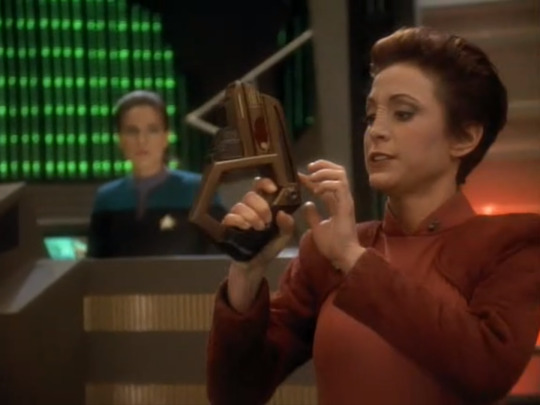
We’re moving on in our character spotlight series from our favorite war criminal captain to one of the most well developed characters from the onset, Colonel Kira Nerys. From the moment we meet her in “Emissary,” we know exactly who Kira is, and the show wisely sends her on a complex journey within that grey area between terrorist and resistance fighter. Get you a Bajoran who can do both.
Ensign Ro may have set the mold for the Bajorans, but Kira grew outside of it and we’re so glad to get her perspective. So pick up your Bajoran phaser and get ready to take aim at some fascists as we celebrate A Star to Steer Her By’s favorite crinkly-nosed, red jumpsuit-clad militia officer in our Best and Worst Moments list below and on this week’s podcast (jump to 56:47). Walk with the Prophets, my child.
[Images © CBS/Paramount]
Best moments
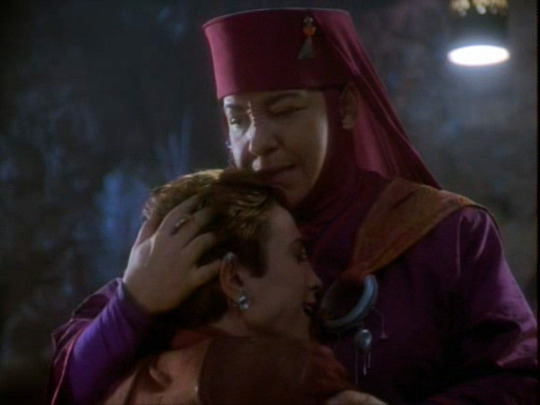
What other show gives you a zombie space pope? There’s more going on for Kira in season one than for other characters because she really rocks it from the start. And Nana Visitor has the chops to give that special nuance to a character like this, especially in emotional scenes like her breakdown when she accidentally gets Kai Opaka killed in “Battle Lines,” and the moment she has with her reanimated corpse is nothing short of stunning.
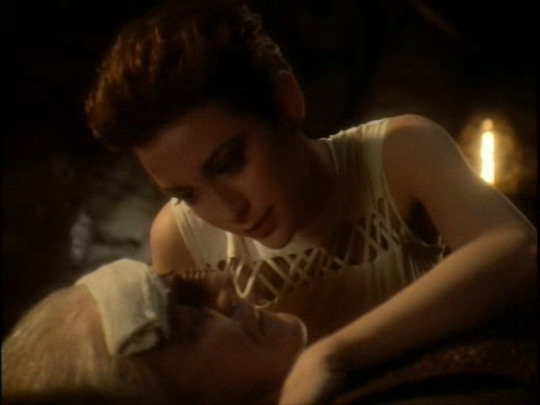
If I leave here, I’ll die Speaking of great moments from season one, Kira makes the hard decision in “Progress” to save Mullibok’s life by ruining said life. Over the episode, she bonds with the obstinate Jeraddo farmer by helping him build his kiln only to destroy it in the end and set fire to his house to force him to relocate, and it’s clear it tears her up inside. Bajorans really never win.

Enough good people have already died. I won’t help kill another. But perhaps the best thing to come out of the season (and to some, the whole show overall) is her character arc in the stunning “Duet.” Kira spends so much of the show battling her Cardassian demons (figuratively and literally), that seeing her grow to accept that some individuals may be redeemable is captivating, heart-breaking, and truly impressive (and have we mentioned it’s only season one?).

A new meaning to being selfish We would be remiss if we didn’t include at least a mention of the excellent and mesmerizing performance Visitor gives as Intendant Kira in episodes like “Crossover.” Say what you will about the mirror universe (and we have), but Kira is a wonder to behold and the chemistry between her and herself is like lightning in a bottle. Zap!
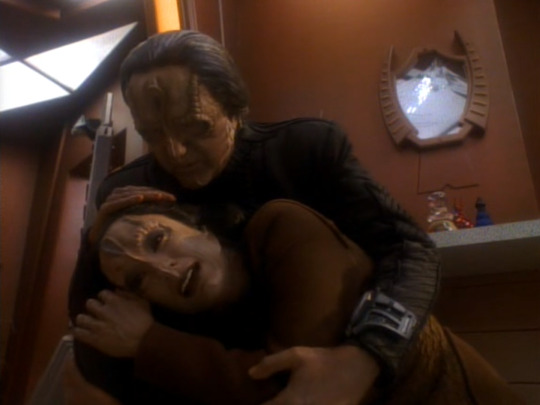
Cardassians LOVE cosmetic surgery Speaking of mirrors, imagine waking up and the face looking back at you in the mirror is the thing you hate most. Kira’s relationship with Cardassians continues to evolve in the wondrous “Second Skin,” in which she bonds with her fake daddy Tekeny Ghemor, foils a Cardassian plot, and discovers a resistance cell within Central Command – her favorite!
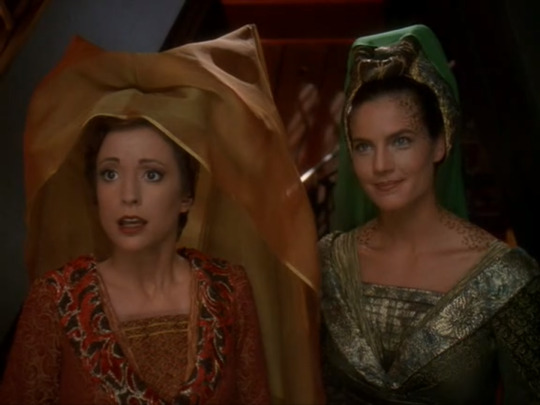
I was playing a married woman This is one of those cute little Kira moments from the show that tickles us, but in “The Way of the Warrior,” it is just too hilarious that her response to being wooed by Lancelot (assumably while playing Guenivere) in the holodeck is to slug him. It’s so in character that we have to applaud it. Kira is always the first to choose violence, after all, though sometimes that can be a downside.
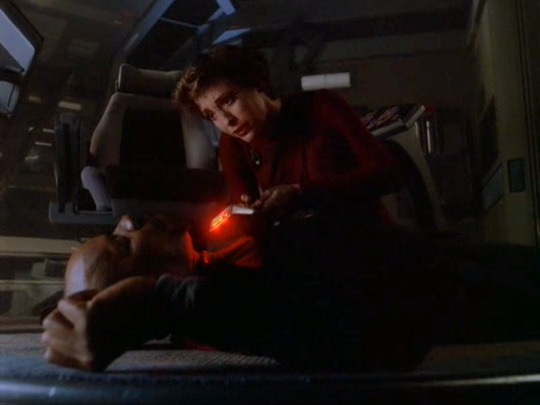
Major, tell me another story Kira spends the second half of “Starship Down” tending to a badly concussed Sisko, and working through character conflict. As I harped on in the Sisko post, Ben is double-fisting roles as both space station commander and Emissary to the Prophets, and that comes with deep significance to Bajorans like Kira, and this is her chance to talk to him about it. Love that for her!
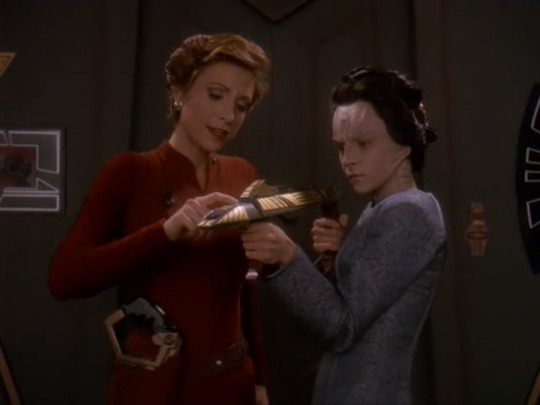
The life you’re choosing isn’t for her There are a ton of great moments between Kira and Ziyal, from saving her life in “Indiscretion” to encouraging her painting in “Sons and Daughters,” but the one we’re highlighting comes from “Return to Grace.” Kira sees that Ziyal is on a dangerous path if she stays with her father, and the bond they’ve established makes her advocate she move to DS9. There’s truly no safe space for the girl, but Kira does all she can.

The baby just had a change of address Thank the Prophets the show didn’t introduce yet another baby when Nana Visitor got IRL pregnant. That’d be way too many babies, so it was rather ingenious to move the O’Brien baby over to Kira in “Body Parts.” And it also highlights just how like family this crew has become. Kira really takes one for the team by agreeing to incubate Kirayoshi for Keiko. Now if only their characters talked more…

I owed it to my father to get it right this time Yet another great character-development episode for Kira comes in “Ties of Blood and Water” when she learns that Tekeny Ghemor – her fake dad and one of our favorite Cardassians! – was up to some shady stuff in his past. And while this alters the relationship between the two of them, Kira again accepts how he’s changed since then to be with him as he dies.
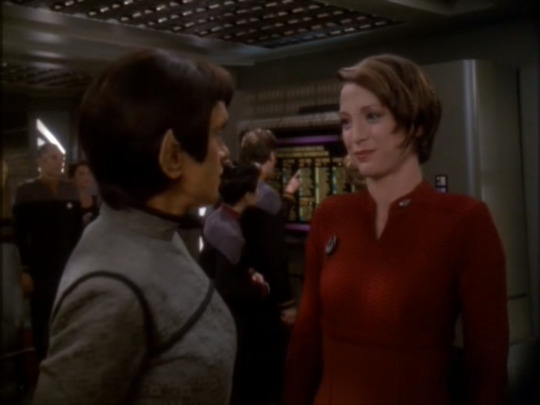
Romulans gotta scheme! Come season seven, the Romulans have gotten added to the mix thanks to some nefarious doings by Sisko and Garak. And Kira is left to deal with their constant scheming. Typical Romulans! Throughout “Image in the Sand” and “Shadows and Symbols,” Kira stares down Senator Cretak in a huge game of galactic chicken, and Cretak blinks first.
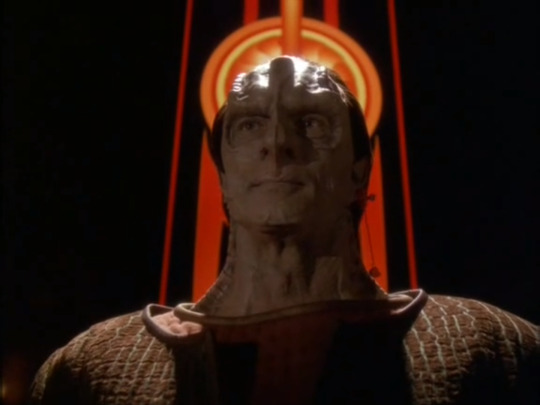
Don’t drink the Kool-Aid Our final great Kira moment is also the last time she ever sees Dukat. In “Covenant,” he’s leading his own little pah-wraith cult, and when the going gets tough, the tough gets really Jonestown-y. Kira literally leaps in and stops the whole assembly from ritual suicide, revealing that Dukat had a placebo pill for himself and he’d had them all charmed. Stupid sexy Dukat.
—
Worst moments
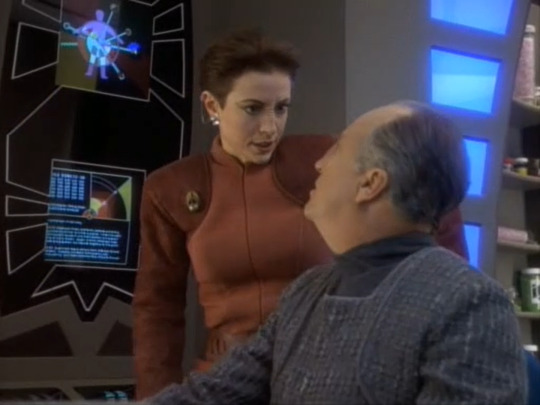
Maybe the ends justify the means? One of Kira’s strengths is also frequently one of her biggest faults, and that’s how very wide her ethical grey area is. She’s able to justify doing lots of pretty messed up things, like a certain captain I could name, and we see this pretty early on in “Babel” when she intentionally infects Surmak Ren with aphasia disease and holds him hostage to find a cure. That’s pretty brutal.

Bajor is not Kentanna For most of “Sanctuary,” it’s rather nice watching Kira befriending Haneek and the other Skrrean refugees. Until they express interest in immigrating to Bajor, and then Kira’s NIMBY side really comes out. It’s not a good look, Kira, especially for someone whose people were in a very similar plight until very recently. And frankly, Bajor could use the laborers.

It’s like stepping on ants, Odo Because of that wide ethical grey area, we’ve noticed that Kira is almost always the first person to advocate just killing whatever the danger of the week is, no matter the consequences. In “Playing God,” an episode about killing Cardassian voles, she’s quick to jump to the option of killing the tiny proto-universe, even when Dax expresses she’s found sentient life in it. Yikes.
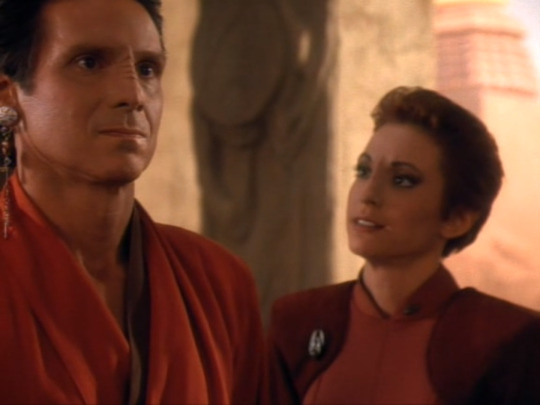
The people have chosen Winn We know from “Battle Lines,” mentioned earlier, that Kira has a super soft spot for Kai Opaka, and also probably feels guilty for trapping her on zombie planet a little. But it’s just a bad idea to let Bareil take the fall for some shady doings in “The Collaborator” because it sets up Winn for the win (wow, I didn’t even try to do that) in the big kai election, lest she sully Opaka’s name.
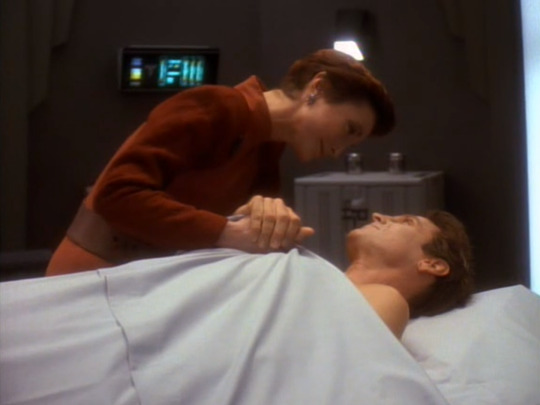
The distant memory of a touch It would be an understatement to say Kira’s taste in men isn’t great (and that’s not even including the fascist she ends up with!). The first of her various men is Bareil, who’s fine but boring as hell. Certainly not worth forcing Julian to keep him alive against all his medical ethics in “Life Support.” But Kira’s into the vedek, so we’re forced to watch her push his existence to the edge of morality and cringe at what he’s becoming.

Do you like me? Check yes or no. Lucky for us, Bareil is a thing of the past by season four (for now), opening up the opportunity for Kira to make more bad dating decisions. While Odo weeps, she sets her sights on Shakaar in “Crossfire” and viewers at home roll our eyes at how high school the whole ordeal is. Why have these resistance cell leaders downgraded to petty relationship drama? It’s beneath them.
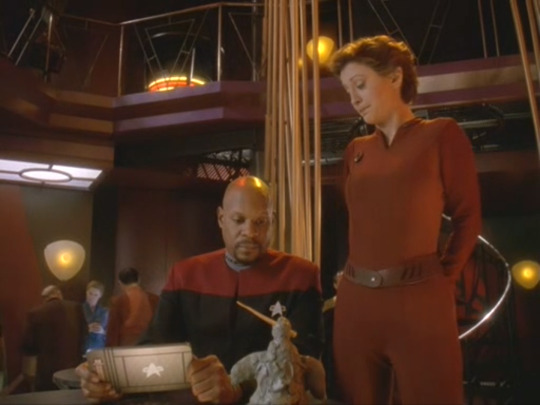
Kira’s edgy artist phase We’ve said it myriad times before, but Bajor is a cultural disaster. When Akorem shows up in “Accession” and declares he’s making Bajor great again by reinstating their rigid caste system, it’s clear that Kira is uncomfortable but still refuses to oppose it. This is a Sisko episode, after all. Even though she can’t sculpt worth a damn, she goes along with the d’jarras like a sheep.

A little lower While Kira is surrogating the O’Brien baby, she and Miles randomly develop feelings for each other only because of their constant proximity in “Looking for par'Mach in All the Wrong Places.” That’s just gross and unnecessary. Nothing again Miles, but men and women are allowed to be friends without wanting to bone. Maybe it was the pregnancy hormones.
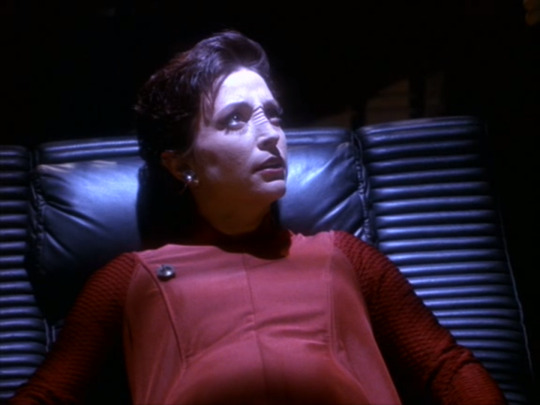
The phantom of Cardassia This one always bothered me. After several seasons of growth as a character, Kira seemed to have chilled out a little in her constant desire to murder Cardassians. So when “The Darkness and the Light” introduces a blast from the past whom Kira would otherwise have at least some empathy for, it strikes me as a character regression for her to fall back on thoughtlessly killing like she used to.

Same face, different universe Kira regesses again in “Resurrection” when a new Bareil is barking up her tree. Oh mirror universe, what have we done to deserve this? Sure, mirror Bareil is at least less bland than the original recipe, but who the hell is this Kira immediately falling for a boy in less than a day? That’s just not the character (that’s Jadzia, if anyone, whom we’ll discuss next week). Kira’d kick his ass.
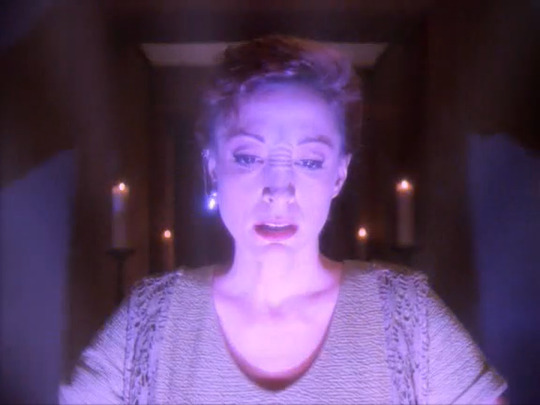
That’s not what your mom said last night I may have given Sisko a little bit of guff for allowing this too, but I’ve got to give Kira even more. Whose first reaction when Dukat makes a yo mama joke in “Wrongs Darker than Death or Night” is to GO BACK IN TIME to check on your mother’s sexual history??? What the hell, Kira??? Now the bigger debate is whether she should or shouldn’t have blown Dukat up. And fight.
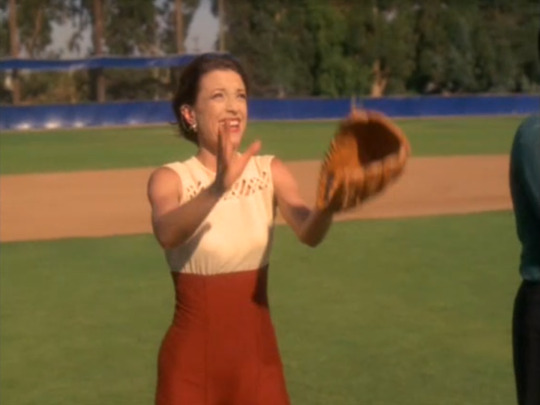
Foul ball! Finally, I need to continue venting about “Take Me Out to the Holosuite.” Somehow, Ben held tryouts on a station full of beefy Bajorans, and still put Kira on his baseball team when she can’t even catch a ball. Kira plays springball in her spare time. She’s a resistance fighter. She was raised to have street smarts. How in the firecaves does she not know how to catch a freakin’ ball???
—
Praise be to the Prophets, that’s all! Keep your subspace communicator focused here for more character spotlights. We have someone who’s multiple characters in one next week when we discuss Dax! You can also go to warp five with us in our watchthrough of Enterprise over on SoundCloud or wherever you podcast, grab some hasperat with us on Facebook and Twitter, and maybe take up sculpting if it’s something you’re actually into.
#star trek#star trek podcast#podcast#deep space nine#kira nerys#bajoran#battle lines#progress#duet#crossover#second skin#the way of the warrior#starship down#return to grace#body parts#ties of blood and water#image in the sand#shadows and symbols#covenant#babel#sanctuary#playing god#the collaborator#life support#crossfire#accession#looking for par'mach in all the wrong places#the darkness and the light#resurrection#wrongs darker than death or night
11 notes
·
View notes
Note
Hasn't nearly every Star Trek production (except maybe Voyager for obvious reasons) had a uniform consistency issue? I vaguely recall one DS9 episode where everyone was wearing the grey uniforms except for one guy who looked he just stepped out of TNG.
That's mainly because Star Trek has never said ON SCREEN what its uniform policy is. The best guess we had when DS9 premiered was that space stations had a different uniform to those on starships (especially in light of Sisko going to earth and switching to a TNG uniform), but then Voyager threw that idea out, same as Generations continually switching between the two uniforms without explanation. And in the case of the episode you're referring to, they probably didn't have it in the budget yet to make admirals' uniforms for the First Contact uniforms (they would later), especially since they JUST spent all that money on the new uniforms for the entire main cast, which required fittings and backups and etc. The policy seems to be one of two things: -Uniform policy is set by whoever is in charge of the ship/outpost and most adhere to whatever is the adopted default uniform of Starfleet. They can decide what uniform design to use for their command. -New uniforms are given a test run in certain areas of Starfleet before mass adoption - there's going to be a new uniform standard but we're testing to make sure they work for interstellar relations/comfort/unforeseen problems with them.
47 notes
·
View notes
Text
He’s supposed to report to Commander Sisko’s office. To greet his new CO. To get his first assignment. To make a good impression.
Unfortunately, his parasympathetic nervous system seems to have other plans.
The shuttle ride to Deep Space Nine — once a Cardassian command outpost called Terok Nor, now owned by the Bajorans and operated in tandem with Starfleet — was largely uneventful, in most senses of the word. They weren’t attacked, no one was taken control of by a mysterious virus, and none of the systems malfunctioned. He had even made a friend on the journey.
At least, he thinks he did. But it’s hard to tell with his stomach roiling this much.
There isn’t much he can do for the feeling. It’s an autonomic response. Anxiety, stress, elevated cortisol, nausea. It’s not new. But it hasn’t been this bad since Captain Picard, Beverly, and Geordi were fighting for his right to seek asylum in a place where he could feel safe. It’s like he’s fifteen again, his head spinning with overwhelm and his digestive tract fighting anything not supplied by his nutrient synthesizer. Except now he eats regularly, and the feeling is crawling up his throat like an insect, making him gag.
His stress distracted him from downloading a map of the station, but miraculously, he manages to find a bathroom. He doesn’t realize which one he’s in until a humanoid woman (Trill, Starfleet science uniform, early thirties—) quietly opens the door and sits a little ways away from him.
“First day, huh?”
He lets out a shaky breath, gripping the rim of the toilet. “Y-yes, sir.”
“What’s your name?”
“Thir—” He stops himself. Shuts his eyes tight and shakes his head. Not Third of Five. He hasn’t been Third of Five for a long time. He spits chyme. “…Hugh.” Stars, his voice is small. “My name is Hugh.”
(Counselor Troi told him that was a more natural way to introduce himself than “I am Hugh.” He wants to sound natural. Human. Even though he isn’t; not really. Not fully. He never will be. He’ll never completely human, and to pretend otherwise is foolish, and he was wrong to come here and he never should have left the Enterprise and he misses Geordi and—)
“Oh, yeah. I heard you were gonna be transferring here. You’ve been working under Doctor Crusher, right? On the Enterprise?”
Hugh manages to look up, and she’s smiling at him so easily, like he was never part of anything horrible. Like he was never dangerous at all. Like he might not be still. Even with dark hair and spots down the sides of her face, she reminds him of Beverly. Even with pale skin and blue eyes, she reminds him of Geordi.
“…Yes.”
“I’m Jadzia Dax.” She offers him her hand. He shakes it, all too aware of the fact that his biosynthetic hand doesn’t sweat, but is almost always clammy. “It’s nice to meet you, Hugh.”
He manages a little smile, even though he’s still shaking. “It’s nice to meet you too, Jadzia Dax.”
#star trek#hugh borg#jadzia dax#star trek au#st ds9#star trek fanfiction#ds9#shut up emrys#art time#mild emetophobia cw#emetophobia cw
25 notes
·
View notes
Text
DS9: Emissary (Part 2)
Read part 1 here. This is the last article wrapping up two-part episodes, which will be in a single article from here on out. Thank you for reading!
Part two of Deep Space 9’s pilot episode opens in Ops, giving us several lovely close-ups of Major Kira’s uniform, including her Bajoran-style comm badge and belt. The badge appears to be made of a brassy metal material, and is in the shape of the Bajoran logo, much like its Starfleet counterpart. The belt, in a deep burgundy colour that matches her uniform, has a texture that suggests reptilian leather (or, perhaps, a replicated substitute). We can also see in this early episode that Kira’s makeup originally included a slight brow ridge, like Ensign Ro.
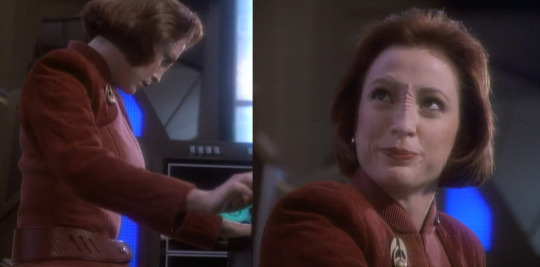
I guess they still have cosmetic surgery in the 24th century.
Odo beams into Ops to join the team, briefly giving us a full head-to-toe view of the goo he has shaped into a brownish-beige Bajoran uniform. My favourite part are the Uggs boots. Do all the Bajoran uniforms come with little booties? They’re not particularly intimidating for the Chief of Security, although they do look like they’d be great for someone on their feet all day.
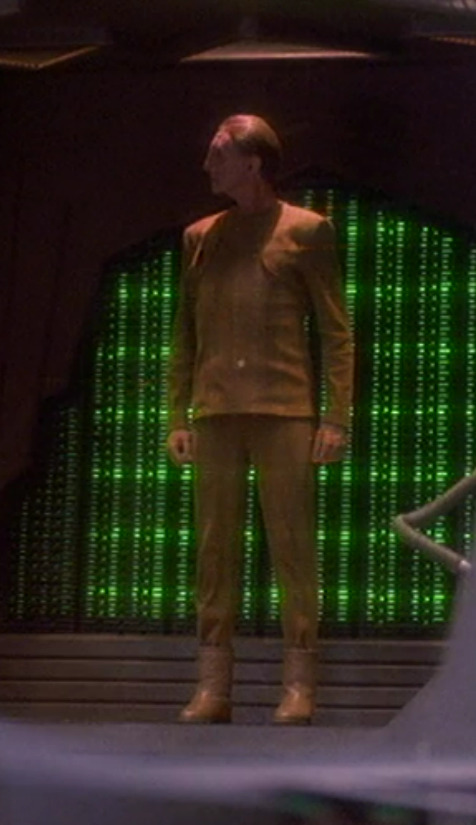
Fighting crime in comfort.
We can also see in this scene that the costume department has decided to flare out the lapels on the Starfleet uniforms; I actually don’t remember if this trend continues into future episodes of DS9, but the same uniforms lay flat on Voyager (which hadn’t yet premiered at this point), so we’ll check back in on that. It’s an interesting styling choice, and kind of makes Bashir and O’Brien look like they’re hitting the club after work.
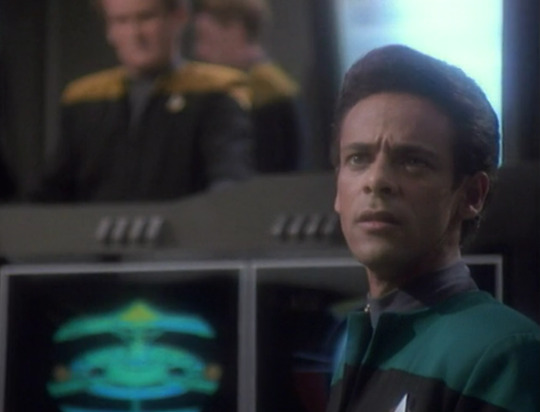
I mean, I guess I don’t know that they aren’t…
Inside the wormhole, Sisko converses with the locals through his memories, and we see the aliens speak to him through various characters. Among them are Locutus in his full Borg makeup and Kai Opaka in elaborate Bajoran religious garb. We saw Opaka in this outfit in part 1, although it looks like they may have draped the outermost layer differently here.
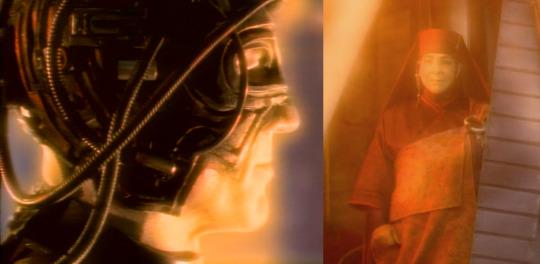
It’s hard to tell what’s changed through the Memory Haze™.
The aliens also take on the appearance of the Chicago Cubs in old-timey uniforms – worn by fictional holodeck characters – and Sisko’s former crew in a TNG-era look. The baseball uniforms will show up again in Deep Space 9, but I suspect the Starfleet uniforms are recycled directly from The Next Generation, giving them a nice on-screen send-off before retirement.
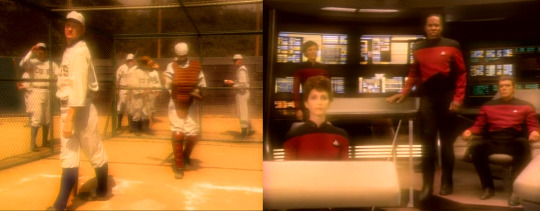
These are all core memories for Sisko.
Back on the station, we get a better look at Major Kira’s Bajoran earring as she jumps on a subspace call with her #1 fan, Gul Dukat. The jewelry is made of a silver metal, with lower and upper pieces connected by a fine chain.
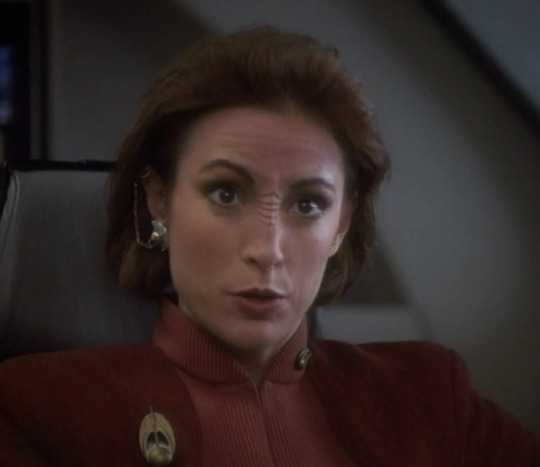
It channels her pagh, as well as six stations of FM radio.
Dukat, of course, shows up wearing the same thing Cardassians always wear, made out of old recycled tires.
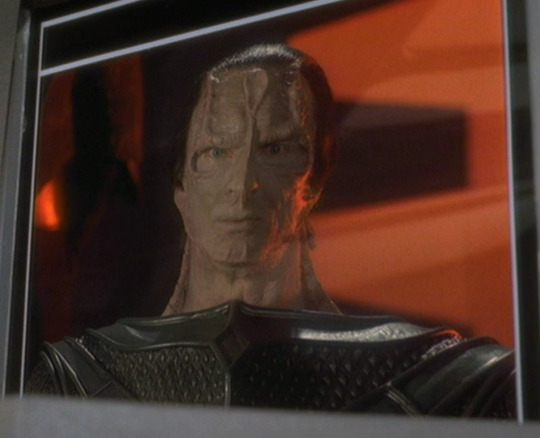
It’s actually very eco-friendly.
Going back to Benjamin, we finally get some new costumes as Sisko finds himself snuggling his dead wife. Well, one of the aliens inhabiting the memory of his dead wife. They’re dressed for a lovely picnic in the park, Ben in a striped jewel tone shirt, Jennifer in an elegant pink dress.
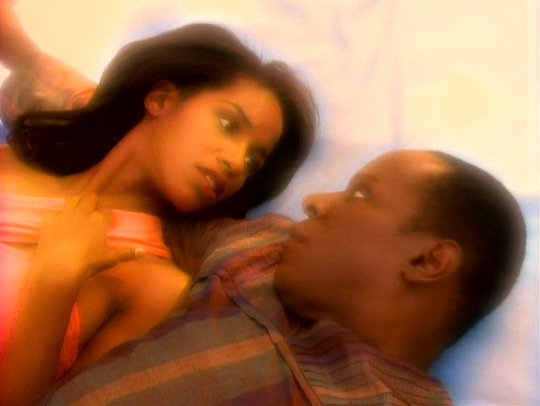
Does this human look good on me?
We can see that the fabric on the top section of Sisko’s shirt has been pleated and pressed flat before being sewn, a trick that seems to be used a lot in Star Trek to create more exotic and visually interesting looks from regular Earth textiles. In this case, it complements the fabric’s vertical stripes nicely. The shirt also has a geometric neckline with a notch in front, giving just a little flirty peek of chest. As we zoom out, we can see it has been paired with an extremely high-waisted pair of olive green pants. From this angle, we can also see that Jennifer’s silky-looking dress tapers at the waist, and has been paired with matching tights and shoes. It’s an adorable look somewhere between “prom queen” and “dance recital.”
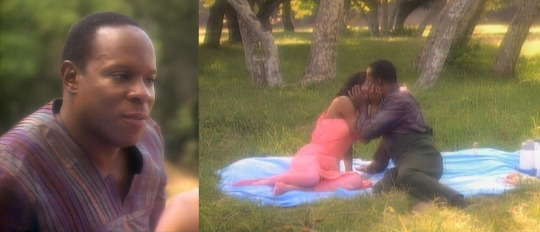
This is what it looks like when you can just beam to a picnic site instead of hiking.
In a scene that’s no doubt just as pleasing to our Commander, we next see him in the memory of a holodeck baseball game, wearing a baseball mitt and cap, while an alien inhabits the image of his son (dressed in a catcher’s uniform) nearby.
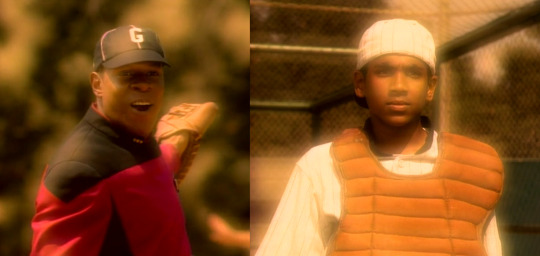
Is this going to become a theme, Dad?
In an incredible bit of attention to detail, even the background actors in this scene appear to be dressed in period-appropriate suits and hats. Then again, it’s very possible Paramount already had these costumes in the back, and they were among the few outfits they DIDN’T need to make custom for this episode.
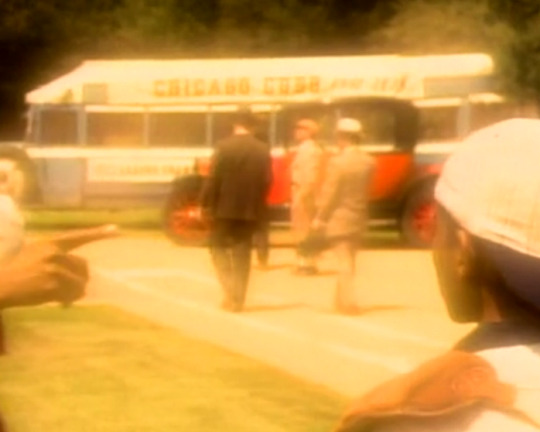
Look, son: normies.
Back on the station, Cardassians have begun to attack, meaning we get to see a crowd of evacuating civilians in one-colour co-ords. Among them is the real Jake Sisko, who isn’t sure about all the monochrome matching.
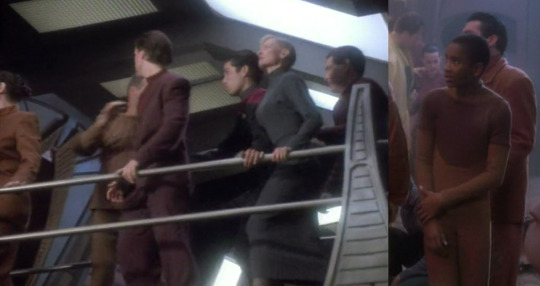
It just doesn’t feel appropriate for the season.
Also present is– what the? What the heck is this guy?! I don’t even know what this alien is, but it has a cute hooded blue dress. If anyone recognizes this species, please leave a comment with the ID!
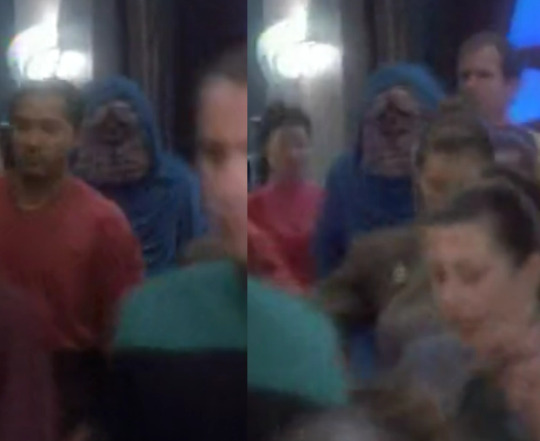
Is it visiting from the Star Wars universe?
We finish out the episode – at least in terms of costumes – with a fantastic showing from Quark. He hasn’t changed since part 1, but we do get a better view of the details of his outfit, including the giant, spherical, shiny buttons on his jacket, which may actually be small doorknobs. The jacket also features sparkly black bands around both arms and wide lapels that flare open dramatically. Like Sisko earlier, he finishes the outfit with olive green pants pulled up as high as they’ll go.
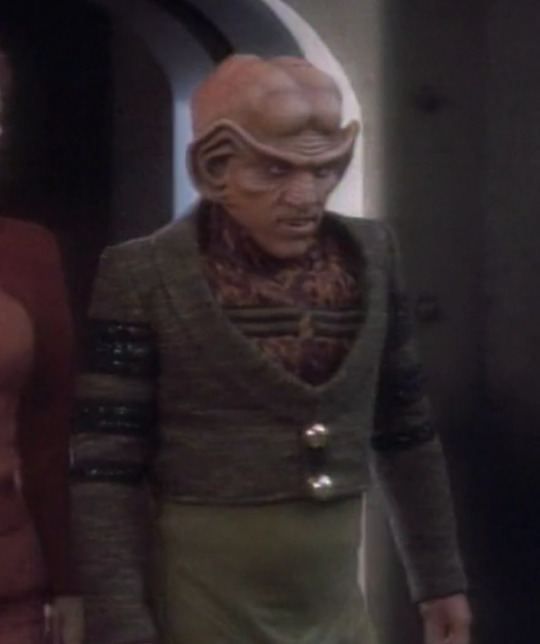
The Ferengi who invents belts will be drowning in latinum.
—
The Costume Designer for this episode was Robert Blackman. The Wardrobe Supervisor was Carol Kunz. Key Costumers include Maurice Palinski, Phyllis Corcoran-Woods, Jerry Bono, and Patti Borggrebe-Taylor.
3 notes
·
View notes
Text
I havent been live-blogging my reading as much lately due to not having nearly as much time to read these days, but the other night I finished reading The Big Game! thoughts under the cut
it was a fun little romp of a book. one of those ones where most characters get a chance to shine, with A plots and B plots wildly differing, and I had a great time reading it. the poker game murder plot was a lot of fun, classic whodunnit vibes, and a fun team up with Quark and Odo. Julian being so eager about poker was very fun and silly, and Garak being a poker shark?? obsessed. I have to say my favourite part was Odo being a poker champion against his will and using it to immediately fuck over Quark. his hater energy stays unmatched
the B plot with the Espiritu and the Ghost Riders was really cool. it felt somewhat disjointed from the poker game plot, with such high stakes going on separately and demanding equal attention, but I think that Sandy Schofield did a pretty good job of juggling both. the way Schofield introduced and described this other phase of reality in the two dimensional was REALLY cool, such a neat concept with a lot of fascinating potential. that two dimensional plane is something I wish we could get more of in the series, I feel like you could do a lot of cool stuff with that concept. I think the Ghost Riders were a bit under-utilized due to not having a lot of time to go into them, they were set up to be a lot more of a threat than they ultimately turned out to be, I wish we could've had more from them and their whole deal with the Espiritu, who were also very cool
the stars of this book for me were Odo, Kira, and Sisko. Odo's story through the poker game was equal parts fascinating on a character level, but also just fucking hilarious. he's so MAD about being good at this game, and having to work with Quark, but he also low-key enjoys the thrill of gambling, its all so fun. Kira's story with the Espiritu, her rage at what's being done to them, and her short time in that second dimensional plane was such a treat to read. my heart broke for her when she accidentally killed one. and man, Sisko truly never gets a break in these books, but this was such a high pressure high stakes situation that his chapters had me on edge. the threat of war hanging over his head, the station trying to break into pieces, murder on the station... and all the while he's worrying about Jake. Schofield does great work with him and how he handles everything being thrown at him, barely keeping his head above water. great character work all around
overall this is a fun book to read for a silly fun time! it doesnt take itself super seriously, and I like that about it. its just a good ol' time and it knows it! if youre looking for something easy to read with a lot of POVs, I would highly recommend this one <3
#star trek: ds9#the big game#I do wish Riker was in this book#they teased me with him and I didnt get to see him#I would've traded a lung to see Riker play poker with Julian and Garak#AND ODO#such a fun book
3 notes
·
View notes
Text
One of the first conversations Sisko has with the Prophets is about non-linear perception; why would anyone want to experience time in linear progression, ignorant of what happens next? Sisko explains the benefit of linear perception through a baseball game– the game is only enjoyable if one is constantly wondering what will happen next.
SISKO: With each new consequence, the game begins to take shape.
PROPHETS: And you have no idea what that shape is until it is completed.
SISKO: That’s right. In fact, the game wouldn’t be worth playing if we knew what was going to happen.
The Prophets are associated with religion, faith, and non-Federation culture; aspects of Star Trek that were either taboo in the writer’s room or in need of ‘correction’ from Starfleet and its futuristic scientists. The Prophets raise a question for the viewer; is non-linear thinking also in conflict with Star Trek’s usual commitment to science and rationality?
-
Star Trek as a whole is both linear and non-linear. In linear fashion, it is a show about the future where technology has advanced humanity to the point that we can explore space, create matter out of energy, teleport, and meet extra-terrestrials. In non-linear fashion, episode premises are often about how familiar problems such as prejudice, war, sickness, and violence reoccur in the future despite the progress of technology and social causes. The show was originally set in an idealistic 2260s, but written to look constantly behind its shoulder at the current problems of the 1960s in the United States. The original series’ politics could be radical at the time it aired; but in non-linear back-and-forth fashion, a show written in the 1960s, set in the 2260s, and still watched in the 2020s reveals outdated and blatantly offensive tropes. At the same time, newer shows written in a post-War-on-Terror United States can feel more conservative than their predecessors. The quality or messaging of the franchise cannot be argued as a linear progression, but is itself a messy and changing reflection of the writers, the show’s subjective goals, and the political atmospheres it’s both created and viewed in. If the franchise (or the audience) was truly linear, then the older series (30-60 years old) would have no meaning or purpose to today’s viewers, and would have been discarded in favor of more recent series. Instead, new generations consistently still find relevance in older series.
-
Star Trek, especially TNG, tends to suggest advancement in technology as an obvious replacement for religion. The simplified linear idea is that a society begins with religion and ends at the ideal state of pure science. The Federation and Starfleet must be good, because they are our main characters, and therefore their exploration and desire to expand their purely scientific culture (linear) must be presented as a logical good.
DS9 challenges this concept not only by investing two of its main characters in Bajoran religion, but by overwhelmingly revealing the horror and tragedy still present in Federation societies with access to advanced technology. The Dominion War (much like the conflict with the Borg) kills tens of millions of people and seems hopeless. The scientifically advanced Federation still employs torture, assassination, forgery, and biological warfare in attempts to win it. Earth, a peaceful and insulated paradise, becomes wracked with paranoia when one Founder infiltrates. Bajor and the space station Deep Space Nine represent a gruesome history of colonization, occupation, and post-occupation, regardless of the occupying force’s technological capacity. The Federation, Bajor, and the Cardassian empire view each other in a barely held together truce with distrust, hatred, and disdain. Even when the Federation sends aid to Bajor, the limits of technology become more visible than they often are on Starfleet flagships. Machines for revitalizing polluted soil are fought over, and homes and land have to be obliterated for mining and energy. The space station itself was built by Bajoran slave labor and during the occupation was used as a dangerous ore processing facility. The toll of technological advancement becomes apparent in a way that Star Trek usually dodges; what does it take to build a space station? Who builds it, and under what conditions? Where does the material come from? Whose home is destroyed in order to get it? Who gets access to this technology? Who profits? If technology has to invent solutions to problems it created with past ‘solutions’ (see: the combustible engine leading to global warming), then has it created an objectively linear progression or a snake racing after its own tail? Is technology objectively advancing humanity if it still creates a massive imbalance of suffering and resource depletion where we choose not to see it?
The alternate simplified linear thinking is, well, okay then, religion is good and technology is bad. However, DS9 also critiques Bajoran religion rather than presenting it as an absolute good. Rather than bashing it for daring to exist at all, it pays attention to moments of corruption, fundamentalism, and power grabs. And technology in DS9, typically medicine, saves people and makes life in general easier. In an early episode called “Paradise,” Sisko and O’Brien crash on a planet where a previously stranded group of people have formed a cult without Starfleet technology. Later, it’s revealed that their leader had manipulated them into crashing, in order to forcibly deprive them of technology and shape them according to her own interest in ‘the ancient religions’; conveniently, she is at the top of their strict power structure. Rather than dismissing religion entirely, Sisko only coldly tells her “Perhaps one day you’ll even feel the hand of God on your shoulder.” The conflict is less about her shallow claims of technology versus religion, and more about her clear desire for punitive and total control over other people.
Both religion and technology are ancient aspects of human life, and cannot be simplified down to opposing or competing ends of a spectrum. Even for a non-religious society or individual, our interest in what’s mysterious or unfathomable about our world gives us humility, comfort, and curiosity; staring at stars or listening to music is not a ‘rational’ exercise that requires explanation in order to feel good. Modern humans evolved with a focused capacity on making and using tools, and the ability to teach and learn between generations, helping us survive and develop art and culture. Perceiving either our interest in the unknown or in science as the only ‘true’ way forward to a better life– however that may be defined– leaves little room for critique of either, and corrupt and exploitative power structures can grow without question. The idea that a single tool forward, a clear linear path, must be decided upon and committed to entirely– whether it’s to a futuristic utopia or existential salvation– tries to dodge the harder questions of personal choice, human behavior, and quests for control that often create the reoccuring problems in Star Trek no matter the time period.
-
Sisko understands non-linear perception of time more personally than other Star Trek characters we’ve seen. He’s studied history, specifically flashpoints of Earth. He’s deeply aware of the racism that would have prevented him from enjoying a 1960s Las Vegas casino. His grief over his wife’s death is what helps him understand the non-linear time of the Prophets, just as his love of baseball helps them understand linear time. He starts off doubtful and clinical towards the Bajoran religion and his posting near the planet, and by the end of the series is sincerely committed to Bajor.
In an episode that focuses on Sisko’s identity as an African American and a Bajoran religious figure, he experiences a past life as a scifi writer in the mid-20th century United States on Earth. The episode explicitly raises non-linear thinking through Sisko’s questioning of whether he imagines the writer or the writer imagines him, and we as the audience watch a man from the distant future see himself as a man from our recent past. Racism, rather than being masked through genre allegory as prejudice against aliens, elves, or mutants, is undisguised racism– the episode deliberately draws the parallel and then removes it again when Sisko imagines racist cops as Cardassians for several seconds. A non-linear problem in Star Trek is it originated as a show interested in civil rights and social progress, and over time became so bogged down in convention and metaphor that fans openly and unironically raged at the idea (both for DS9 and Discovery) of a Black captain and perceived ‘political correctness’. The episode points to the linear through-line of scifi, when Sisko’s past self asserts that even though his story about a Black astronaut will not be published, the fact the idea existed at all proves it could one day happen. The events that lead from Benny Russell’s story to Benjamin Sisko’s existence, however, are hardly a straight line. Sisko’s actor, Avery Brooks, experienced racism on the set of the show, both from showrunners and lot guards who racially profiled him when he would drive in to the parking lot. Even in Star Trek’s stated premise of a future where prejudice on Earth has disappeared, the franchise itself has been plagued with overt racism, sexism, and homophobia. Sisko’s character, despite existing in a show that is supposedly post-racism, shows the way progress does not move forward in a neat line, but often double-backs and pulls constantly from both the past experience and knowledge of the oppressed, and from the past prejudice and control of the oppressor.
-
In the episode “Explorers,” Sisko’s fascination with history, Bajor, engineering, and being Jake’s dad overlap. He researches and builds a traditional 16th century Bajoran spaceship that ‘sails’ on solar energy. If Sisko wanted to warp across the galaxy or replicate a model of the ship, he easily could. However, the ship for him serves as a pleasurable hobby, a way to bond with his son, and a deliberate retreading of the past and the experience of the people who lived it. The Cardassian empire (which often justifies its occupation of the Bajorans by claiming them to be technologically inferior, overly spiritual, militantly unambitious, and further behind in the Cardassian empire’s ‘linear’ understanding of a civilization’s progress and therefore right to exist) turn their nose up at the ship and its capabilities. By the end of the series, the Cardassian home planet’s reward for its commitment to technology, nationalism, and imperialism is revealed; even before the planet is brutalized by Dominion forces, it is a hollowed out, deeply polluted, and barely livable core of an empire starving for external resources to continue feeding its survival and ‘linear’ expansion. To the Cardassian empire, linear growth of capitalism, the military, and imperial reach was the perfect goal– it ends inevitably with mass casualties of its own population and major divisions. The survivors of the former empire, rather than start over and regrow into the same plant so it can hit the same brick wall, have to stop and simultaneously consider their propagandized history, devastated present, and uncertain future. The only way to actually progress and break the cycle is by questioning what their society considers progress to begin with; unstable imperial domination or sustainable peace?
-
A scientific example of forcing non-linear science in a linear box is evolution. Evolution is sometimes falsely believed to be a process which will result ultimately in a superior, perfectly adapted species; a belief that at its most harmless is used to stroke our own egos as ‘the apex predator’ and at worst used to justify eugenics. However, evolution is a non-conscious process that simply creates and recreates species that can fill whatever niches exist in the moment. A species perfectly adapted to flight in dense jungles will fail completely if placed at the bottom of the ocean. A species adapted to both will waste bodily form and function on trying to check every box, and likely be edged out by more specific competitors. There is no end goal, only a series of events happening constantly, shaping, and reshaping, sometimes retreading genetic history for a pair of legs or a life in the water again, sometimes building up to something that does well until it doesn’t, from the largest whales to the smallest bacteria.
A more poetic way to think about all of it is Ursula K. Leguin’s quote, from the relevantly titled sci-fi novel, The Lathe of Heaven; “Love doesn't just sit there, like a stone, it has to be made, like bread; re-made all the time, made new.”
Faith, technology, even the DNA of every species cannot be seen as arrows reaching a specific target, that once reached, will prevent all past problems forever onward. The argument is not that progress can never be meaningfully achieved, and neither is the argument that progress once reached will remain concrete and fixed. The argument is that any effort, making bread or a tv show or a better world, has to be constantly made, remade, pushed, held, and examined. When a modern problem arises in Star Trek, it is because the conscious effort necessary to solve that problem has grown stale or become forgotten. Characters solve their problems, with the help of technology, and in DS9 with the help of faith, but mostly with the will to confront the issue, to work collectively, to use intelligence and compassion, to bear what cannot be easily solved, and to understand the past’s continued relevance in the present and the future. Even as we perceive time in a linear fashion, and we hope to leave the world better than we found it in whatever way we can, we need non-linear understanding to consistently weave and mend our own places within history. In Star Trek, both Earth and the Cardassian Empire have similar technological advancements– but Earth only achieved warp-travel and replication technology after undergoing World War 3 and being forced to solve its social and ethical crises. Technological advancements in both societies veered into rapidly different results based on the differing cultures, and even then, future Earth risks settling into a fragile state of content ignorance rather than permanent utopia. DS9 implies that Earth’s progress depends on its capacity for maintained social self-awareness rather than technology. We need non-linear understanding to keep from kidding ourselves that we’ve permanently ‘solved’ some great problem of life, either through smaller phones or psuedo-spiritual epiphanies, and no longer need to worry about mistakes from the past. We need non-linear understanding to recognize when a step forward really has happened, and to make sure we remember that step has to “be remade all the time, made new.”
-
In the first episode, we watch Sisko calmly and rationally explain to the Prophets our reality; that we live from one moment to the next, and use our past experiences to inform our decisions in the present about our future. The Prophets start to understand, but they distrust linear life for what they perceive as aggression, adversarial behavior, and lack of responsibility. We watch a capable Starfleet officer and an intelligent human being explain the most intrinsic and inevitable part of our lives; that we can only move forward in linear time.
However, it is only once Sisko breaks down after repeatedly bringing himself to the death of his wife Jennifer, that the Prophets tell Sisko he exists in that moment and trust him. Beings moving through linear time do not do so carelessly; Sisko begs that he does not want to be at the moment of Jennifer’s death, that he wants to leave it behind; but he can’t. The moment existed, and will always exist for him. Sisko, crying, admits that “it’s not linear.”
#THIS HAS BEEN DRIVING ME NUTS TRYING TO EXPLAIN TO MYSELF.#ds9#i still can't totally throw the dart at it but hm#i would even argue that by the end of TNG picard has changed from someone wholly married to 'we have moved forward thanks to the objectivity#of science' to 'damn i have experienced a lot of wild shit. oh the space god who's obsessed with me is here#again. sure why not'
17 notes
·
View notes
Text
waits, inexhaustible, the universe
Written for trektober: Day 26 artificial gravity
They had left Lenara behind—being neither Starfleet, nor a medical or engineering expert, nor even a simple solider, she was left behind often.
The counselor, the little brave thing who had recently taken on a symbiont through a series of unfortunate emergency circumstances, appeared very determined as she boarded the Defiant, an optimistic sort of sturdy to pair with Doctor Bashir’s energetic care. Both people and their expertise were needed for the worn-down and bloodied garrison ringing out for help. Lenara, the wormhole consultant, was ordered to stay by the wormhole.
Jadzia had wrapped a long arm around Lenara’s waist as she departed, kissing her hairline and then her mouth, grinning in her horrific, impish way that never settled Lenara’s fears before Jadzia went into danger.
“We’ll be back before you know it,” Jadzia had said.
“Oh, well, in that case,” said Lenara. “I won’t worry at all.”
And Jadzia had laughed as she left the circle of Lenara’s arms.
Lenara thought of that laugh now, as she hit the switch for the improvised console to initiate turning the artificial gravity back “on.” Between her and Miles, they’d managed to make the console as complicated as possible, messing with the specific “gravity” of the station—so complicated that it was a miracle they’d not accidentally ripped the station in half while attempting to fight off far more of the Jem’Hadar than any one Deep Space outpost should be called upon to do, even one on the very front line of the war. Still, the Jem’Hadar had been ousted, only one ship able to dock on the shifting reality that was the station, and now Lenara, exhausted and bruised, could effectively restore the “natural” artificial order of things before the real heroes returned.
She landed on the grating floor loudly and ungracefully, but who could blame her.
Miles found her in minutes, with one of his phasers still brandishing about, bleeding a little from his temple.
“When I find out how they cloaked themselves like that,” he said, not for the first time, as he helped her undue their field transportable gravity machine. “I’m going to blast every one of them out of they sky with a Death Star.”
“A what?” asked Lenara.
“Christ, but I’m pissed,” Miles went on. “Where the hell was our intelligence?”
Lenara wiped her fingers free of the goo from the electrical tape and then pushed her hair off her forehead. “Evidently, inadequately engaged.”
By the time the crew of the Defiant had returned, looking weary and unhappy and entirely not prepared for dealing with whatever chaos had occurred in their absence, neither Lenara nor Miles had had much time to clean up beyond restoring the artificial gravity and ensuring regular environmental systems were functional. The security officers who’d taken the brunt of the action were summarily sent to bed so Sisko and co. had the pleasure of greeting the very sweaty and greasy and annoyed Lenara and Miles who were sitting in Ops and trying to figure out how the particle scanners were so flummoxed by the new Jem’Hadar ship design.
“What on Earth…” said Sisko, looking around at the various detritus and also at their dirty, tired faces. Kira, Ezri, Bashir, and Nog all seemed to echo to this sentiment.
Jadzia whistled, impressed. Which, of course, made Lenara's heart flutter.
Before Lenara could properly express her bone-breaking relief that Jadzia was alive and apparently well enough to ironically comment, even by mere sound effect, on something clearly serious, a new idea occurred to her about the more pressing issue.
“They’ve linked with the ship!” she gasped at Miles. “The Changelings have embedded themselves in the ships!”
Miles frowned. “That doesn’t make any sense.”
Lenara frowned back. “No, I suppose you’re right.” She thought. Then, “No, wait, you're not. it does make sense. The Klingon cloaking worked by throwing off any and all scanners for any and all EM radiation. These worked by gravitational warp—subspace”—
“Oh, like the Houdini mines,” said Jadzia, with yet more irony.
“Sure!” said Lenara. “I don’t know what those are but”—
“How do Changeling’s affect gravity?” asked Miles.
“The Link,” said Lenara, grinning. “They all have a certain location, even when they’re not at that location. Pretty strange quantum qualities, altogether.”
“So some of the Changeling’s are posing as ships for the Jem’Hadar?” mused Miles. “That’s not a great development.”
The pursuant conversations and debriefs moved fairly quickly for Lenara, who was riding a small high (and a lingering surge of adrenaline) at discovering yet another instance of extreme gravitational phenomenon being directly affected by a species of conscious life, and so it took her utterly and nastily by surprise when, hours later, in what was supposed to be the peace of their quarters, Jadzia had taken off her shirt to reveal a level of unholy bruising and injury that Lenara, as a rule, found unacceptable.
“What happened?” she asked, running her fingers over the edges of the bruises around Jadzia’s ribs.
Jadzia shrugged. “Thrown into a wall a couple times.”
Lenara considered this. Imagined it. Lost the ability to think.
She dropped to her knees and wrapped her arms firmly around Jadzia’s hips, burrowing her face into the softness of Jadzia’s bare middle. The terror of the day had caught up to her, a bit later than usual, but now very much present. She needed to stay in this exact position for approximately a week before she could dare face another.
She hadn’t realized this is what her life would be like after saving the life of a war hero and subsequently abandoning the stability that had so prevented her happiness years before. Everyday she was reminded of the war, everyday she woke to up a terror, everyday was filled with a range of emotions that required a complete reorienting of self that she hadn’t needed to perform since she was Joined. Memories of war from past lives did nothing to prepare her for saying goodbye to Jadzia, fearing for her life, and then seeing her again, changed but not dead. Lenara had recently added more slow-burn food-types to her meals in order to properly manage her quotidian experience, such was the energy she was using to go from desperate fear to depraved relief in so short a duration of time.
This day, at least, she had been called upon for a more expansive focus than the normal monitoring of the space station and wormhole. Regardless, she needed to press her face into Jadzia’s soft darkness and remember that Jadzia did, in fact, still exist and, thus, there was yet hope for it all.
Jadzia bent over her, brushing her fingers through the oily strands of Lenara’s hair, and holding Lenara close as she came down.
“It all happens so fast,” she said into Jadzia’s belly. “Everything. It's so quick.”
There was a beat in which Lenara could feel the hitch in Jadzia’s breath through the skin of her face. Jadzia, typically, preferred to fall apart once a day by crying silently into a pillow and pretending Lenara couldn't hear and that she couldn't feel her petting her back. Something must have changed in Jadzia for her to start crying when the lights were still on.
“I’m sorry you’re here,” said Jadzia, her voice breaking. “I’ve just realized—I’m sorry you’re here.”
Lenara squeezed her arms around Jadzia tighter. This would not do.
“I’m not sorry, don’t you dare,” she said immediately. “It’s moving fast but this…” She swallowed, nuzzling into Jadzia. “Someday, it’ll move slow.”
Jadzia’s hands continued to stroke Lenara’s head, shoulders, and neck. She said, trying for a bit of humor, “We just need some good old fashioned time dilation.”
“I can do it,” said Lenara. “Expand the gravitational force on everyone else, except us.”
Jadzia laughed wetly. “We’ll go to the beach.”
“Yes, I’ll swim and you can collect slimy creatures to adopt.”
“It will be slow,” whispered Jadzia. “One day.”
Lenara allowed herself one more moment of peace before extricating from Jadzia and saying, “Let’s go to sickbay—you look like you’ve been thrown into a wall.”
3 notes
·
View notes
Note
Trick or treat!
(for this ask game)
Lol, thanks for sending this on anon because I didn't want to curse anyone I actually knew with my weird siskarak bullshit but since this is anon I can safely send you a fic about my most beloved cursed rarepair, mwahahaha! <3 Anyway, here's a very rough draft (written today lol, def subject to change) of the start of a Way of the Warrior siskarak fic (working title "A New Suit"):
Just as he finished trying yet again to sell Morn on the concept of Vitarian wool undergarments, Garak’s communicator buzzed against his chest indicating an incoming call. He didn’t get many comms besides his dear Doctor inviting him to lunch (or letting him know he’d be late for the same), but they’d already eaten together today so this was quite unusual. He allowed the call through.
“Mr. Garak,” said Sisko’s voice, “I'd like to see you in the wardroom immediately. Bring your tailor's kit.”
He raised his eyeridges intrigued. Did that mean what he thought it meant? Was Sisko finally taking him up on that offer he’d made a few years ago?
After a stunned moment, he acknowledged the request and closed the line.
His blood pounded in eager anticipation as he gathered his tools from his workbench and packed them into a small case. Measuring tape, pins, chalk, sonic stitcher… He also tucked a few condoms into one of the pockets on the inside.
He locked up his shop and walked down the Promenade towards the turbolift that would take him to the command level, maintaining his usual gait despite wanting to rush to this encounter. The choice of location clearly indicated that Sisko wanted discretion. They couldn’t meet in his office without Garak walking conspicuously through Ops, they couldn’t meet in either of their quarters without it being obvious exactly what they were up to, but the wardroom had multiple routes that could be taken to get to it. Warmth coiled between his legs. He had to admit, he quite liked the idea of being Sisko’s dirty little secret.
The turbolift whirred. He wondered if Sisko would take him on the table, or up against a wall. Or perhaps in the window, on vulgar display to the stars (and any passing freighter crews who happened to look).
He stepped into the hall. He felt like he was on the brink of everting already. It had been quite awhile since his last bit of… company. Quark had been the first to hear the rumors of Terok Nor being about to fall under Federation control and, in a low moment, Garak had duly rewarded him for passing along this valuable information. But the experience hadn’t been one either of them was willing to repeat, so he’d stuck to doling out more conventional rewards for information since. And as for enjoyable company… well, that had been longer ago still.
Garak had never quite been able to give up hope that his dear Doctor would one day let things progress past flirting and take him to bed (and then, ideally, rail him so hard that he’d forget how cold and lonely his existence was, for a moment). But, aside from the incomparable Julian Bashir, Sisko certainly had to be one of the most physically attractive residents of the station.
Sisko was, of course, just as hopelessly brainwashed by his Federation values as dear Julian, but he certainly didn’t seem to hesitate when it was necessary to momentarily route around such values in order to work towards a future outcome that was more in line with them. Garak found his pragmatism quite refreshing.
Not to mention that there had always been something compelling to him about power and commands… If Sisko ordered him down on his knees, he would surely drop to them instantly with little regard for the sorry state of his ever stiffening joints. Just look at how embarrassingly fast he’d come running when he’d called.
The tip of his thorn slipped out unbidden. He squeezed his thighs together to keep himself from everting fully. It was a mercy that he hadn’t encountered anyone in the corridors. He was rounding the last corner now…
He entered the wardroom and froze.
He realized quickly that either his assumption about the nature of this meeting had been incorrect, or Sisko had planned something much kinkier than he’d expected. It wasn’t just Sisko in here, it was nearly the entire senior staff—though no Julian, thankfully. Sisko stood in the center of one part of the room, with all of the others either seated or standing around him. If there was one good thing about this, it was that any of the concerns from a moment ago about everting too early had vanished, as he now felt more confused than aroused.
When Dax finished rattling off some kind of statistics about fleet movements, Garak spoke up, and everyone turned toward him.
“Excuse me. I hope I'm not interrupting,” he said, hoping for some explanation before he embarrassed himself.
“I'd like to be measured for a new suit.” Sisko said it very seriously, but there seemed to be laughter buried inside of it. The edges of his eyes were crinkled from the slightest of smiles.
Moreover, his words felt like some kind of code, but Garak wasn’t sure for what. What made it all feel even more ambiguous was that when Garak had overtly propositioned Sisko during the Natima Lang business, he’d specifically couched it in terms of fitting him for a suit. Just like Sisko was now asking him for.
Garak licked his lips. “Now?”
“Right now,” Sisko said. Where Garak was uncertain, he was definitive.
#siskarak#(one-sided siskarak)#ds9#ds9 s4e1 The Way of the Warrior#references to Profit and Loss too#trick or treat ask game#ask game#my fic#all dialogue is directly from the episode transcript#I'm aiming for a missing scene type of fic but i still need to rewatch that scene for canon compliance lol
14 notes
·
View notes
Note
🥃 Elim Garak/Benjamin Sisko
🥃 Elim Garak/Benjamin Sisko for the rarepair ficlet game.
It was easy, as it turned out, to come up with excuses to be alone with Garak.
Ben insisted upon keeping their debriefs and other work related meetings professional—despite Garak’s hinting, he would not have sex with him in his office—but there were plenty of reasons for a station’s captain to just so happen to end up in the company of the station’s tailor-cum-intelligence contractor and no one else.
Ben would be lying if he claimed he hadn’t planned on using the senior staff dinner as another one of those excuses.
[Fic under the cut due to length.]
It was unusual for Garak to be invited along, even with his recent employ by Starfleet, but not so unusual that it would raise many brows. And, recent circumstances between them being what they were, he’d been certain that Garak would see the invitation for what it really was.
It should have been easy. Convenient.
A nice reprieve from the dark cargo bays and closed tailor's shop—admittedly, it was usually the tailor's shop—that their rushed trysts usually took place in. And while he had hosted Garak in his quarters previously, there were only so many private dinners a station's captain could have before questions would inevitably arise.
So this had seemed the perfect solution.
All they needed to do was wait until everyone else went home or had drunk enough to be sent home, and then they would have the opportunity to savor the experience.
Only, Ben hadn’t accounted for... Garak.
Garak had arrived alone, long after everyone else had arrived, wearing an off-the-shoulder top and bold blue pigments painted on his face and neck. And in case he wasn't being clear enough at projecting his intentions to the crew, he topped it off by casting sultry glances Ben’s way all throughout the evening.
It wasn’t like Garak to be so indiscreet, not without a purpose anyways. And so Ben had done the only thing he could do without starting a scene and likely playing into his hands: he ignored it.
What should have been a relaxing night, instead proved to be excruciating. He felt embarrassed for both Garak and himself every time he so much as looked at the man, and it was evident he wasn't the only one as one-by-one everyone else left, notably earlier than usual. (Ben could only be thankful that Jake had had a deadline he needed to meet for the news service, and thus had turned down dinner.) The lone exception was the presence of Doctor Bashir, who only left, giving Garak a lingering look, when the looming threat of his overnight shift had become unavoidable.
That had been more than fifteen minutes ago.
There were two wash bins set on the counter, one filled with soapy wash water and the other with clear water for rinsing. Ben worked quietly at them, taking solace in the scrubbing clean of plates and silverware. Garak had remained, ostensibly, to help with dishes, and so Ben made sure he did. Every clean dish was handed over to Garak to dry and set on the counter.
He handed another one over. Dry scaled knuckles brushed against his wet fingers, as Garak grasped the dish. Ben didn't let go.
Their eyes met.
“What do you think you’re doing?” Ben asked quietly.
Garak’s eyes widened in mock innocence. “Why, I’m helping our Captain clean up after feeding the crew such a charitable dinner.”
Ben stared at him. Then he released the dish into Garak’s hands and turned with a sigh to reach for a discarded wet dish towel.
As Garak finished with the dish and set it aside in the finished pile, Ben grabbed his upper arm, avoiding the bared flesh of his shoulders, to turn him back around. Garak flinched as Sisko's hand came for his face, but instead of the fist he was apparently expecting, it was the wet press of the dish cloth, scrubbing the pigment from him like Ben used to wash a much younger Jake behind the ears.
“Why did you act like that tonight?” he asked.
“I don’t know what you mean.”
“Garak,” Ben said, frustrated by the coquette act. He tossed the towel aside, keeping a grip on his bicep.
Garak’s fingers reached out to fiddle with the loose tie on Ben’s apron.
“Does it bother you?” he asked, eyes downcast and fixated on the string. “The idea of them knowing?”
“Yes.” As if that could even be a question. “Garak, I- We shouldn’t even be doing this. I’m in a relationship.”
Garak’s eyes returned to his. “Yes, the sublime Captain Yates who hasn’t been back to the station in more than a month. It’s perfectly normal, you know. On Cardassia, it’s practically even expected, though no one in their right mind would say it aloud.”
“And what is it, exactly, that’s expected?”
“Oh, just a certain level of frivolous companionship. The Archon with the housekeeper... The Gul with his Bajorans...”
Ben scoffed. “Is that what you think you are, Garak? My mistress?”
“Well, it’s not quite the word I would use for it.”
He tightened his grip on his bicep. “What word then? Comfort man?” he said, and then aiming to wound, “Whore?”
Garak stared back, unmoved. “A little on the nose, wouldn’t you say?”
Ben dropped his grip and turned back to the wash bin, holding onto the counter’s edge for support. “We can’t keep doing this.”
It wasn't the first time he'd said those words.
Gentle hands landed between his shoulders, pressing into the tight muscles there and kneading his flesh.
“Oh, but we can. There’s a war on, Captain. There’s no point wallowing in our personal moral failures when we could all die tomorrow. One must live”—the hands smoothed down to wrap around his ribcage and guided Ben to turn around, back against the counter—“while we still can.”
Garak's eyes were almost feverishly bright. A faint smudge of pigment remained on his forehead, smeared outside of the lines of his crest. He leaned in, long lines of ridges visibly darkening with their proximity. He was a hairsbreadth away. Breaths ghosted across Ben's lips.
Ben leaned in to kiss him.
10 notes
·
View notes